CBD Statistics: Usage Data & Demographics (2024 Update)

Report Highlights
- 26% of Americans are using CBD in 2022 [12].
- 64% of CBD users use CBD for pain [39].
- 21% of men and 16% of women in the US have tried CBD [32].
- 50% of pet owners use CBD for their pets [45].
- 35.12% of vets recommend using CBD for pets [7].
- The top-selling CBD product is CBD tinctures at $976.07 million [20].
- $5.31 billion was spent on CBD products in 2021 [18].
- $560 million was spent on pet CBD products in 2021 [4].
- Delta 8 is 2/3 of THC’s potency, with 80% saying THC is more potent than delta 8 [34].
- 16.7% or 1 in 6 marijuana users use delta 8 THC [37].
- 51% use delta 8 THC for mental health problems and 41% for pain [33].
- Retail sales of delta 8 THC reached $10 million in 2020 [53].
- 76% of delta 8 THC products contain more than 0.3% THC. Some have 1.3% to 5.3% THC level [43] [34].
- 25% of brands don’t test for purity [29].
- Only 16% of brands contain what’s stated on their product labels [29].
- Unintentional exposure to delta 8 THC caused the death of one pediatric case [1].
What is CBD?
CBD is one of the hundreds of cannabinoids produced by the cannabis plant (Cannabis sativa), a species that includes both psychoactive marijuana and non-psychoactive hemp. It’s the second most popular cannabinoid after THC — the major cannabinoid that produces the high associated with the cannabis plant. However, unlike THC, CBD won’t get you high. Not only is CBD non-psychoactive, it’s non-addictive as well [38].
Hemp-derived CBD products have quickly gained popularity in the health industry. Many consumers use CBD as a health supplement or as a natural remedy for symptoms ranging from pain to seizures. It’s a safe compound that can be used for many health purposes [31].
Types of CBD Products
Today, you can see hemp-derived CBD products not just in dispensaries and health stores but online as well. It’s found in many forms, the most popular of which include:
- Sublingual CBD like CBD oil and tincture
- CBD edibles like gummies, chocolates, capsules, and tablets
- CBD topicals like ointments, creams, and balms
- Inhalable CBD like hemp flower, vapes, and pre-rolls
- CBD skincare products like CBD bath bombs, lotions, and makeup
- Pet CBD oils
- Pet CBD dog treats
What is CBD Used for?
People use CBD from the cannabis plant not only to help relieve symptoms but also to help maintain optimal health. It interacts with the body’s endocannabinoid system, the primary function of which is to ensure the body is always in a state of equilibrium or balance. CBD also stimulates other non-cannabinoid receptors that modulate physiological responses [49].
Top Reasons Why People Use CBD: What Do Most People Use CBD for?
64% of Americans are using CBD for pain [39].
Anxiety and stress come in second place at 49%, and sleep and insomnia are in third place at 42% [39].
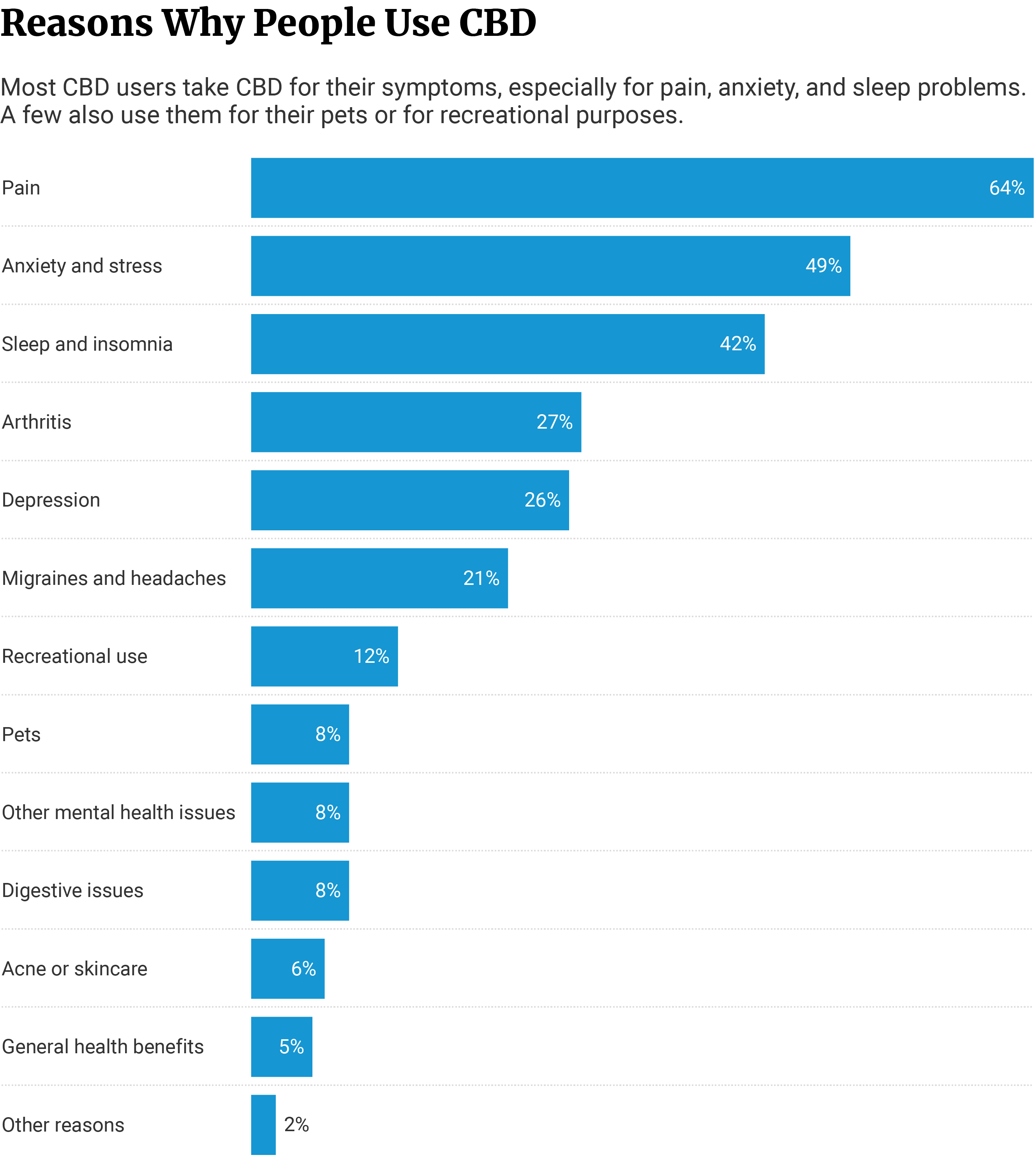
Is CBD Effective?
75% or nearly three-quarters of American CBD users say it’s moderately effective for the symptoms they’re taking it for. About 48% or nearly half of them say it’s very or extremely effective for their symptoms. The data was gathered from a 2019 survey of 4,000 American CBD users [27].
37% of the respondents use CBD for stress and anxiety. 63% or over 3 in 5 of them find CBD very or extremely effective [27].
24% of them use it for joint pain. Of this percentage, 38%, or nearly 2 in 5, found CBD helpful and effective [27].
11% used CBD for fun and recreational purposes. There’s no significant difference between those who found CBD effective for recreational use (24%) and those who didn’t (22%) [27].
10% said they used CBD to enjoy better sleep. More than half of them (52%) found CBD effective [27].

30% of the respondents took CBD together with their other medications, while 22% of them entirely replaced their medications with CBD [27].
- Of the 22%, 47% of them replaced OTC painkillers with CBD, while 36% of them replaced their prescription painkillers with CBD.
- 33% replaced their prescription drug for anxiety with CBD.
- 22% replaced their sleep-aid drugs with CBD.
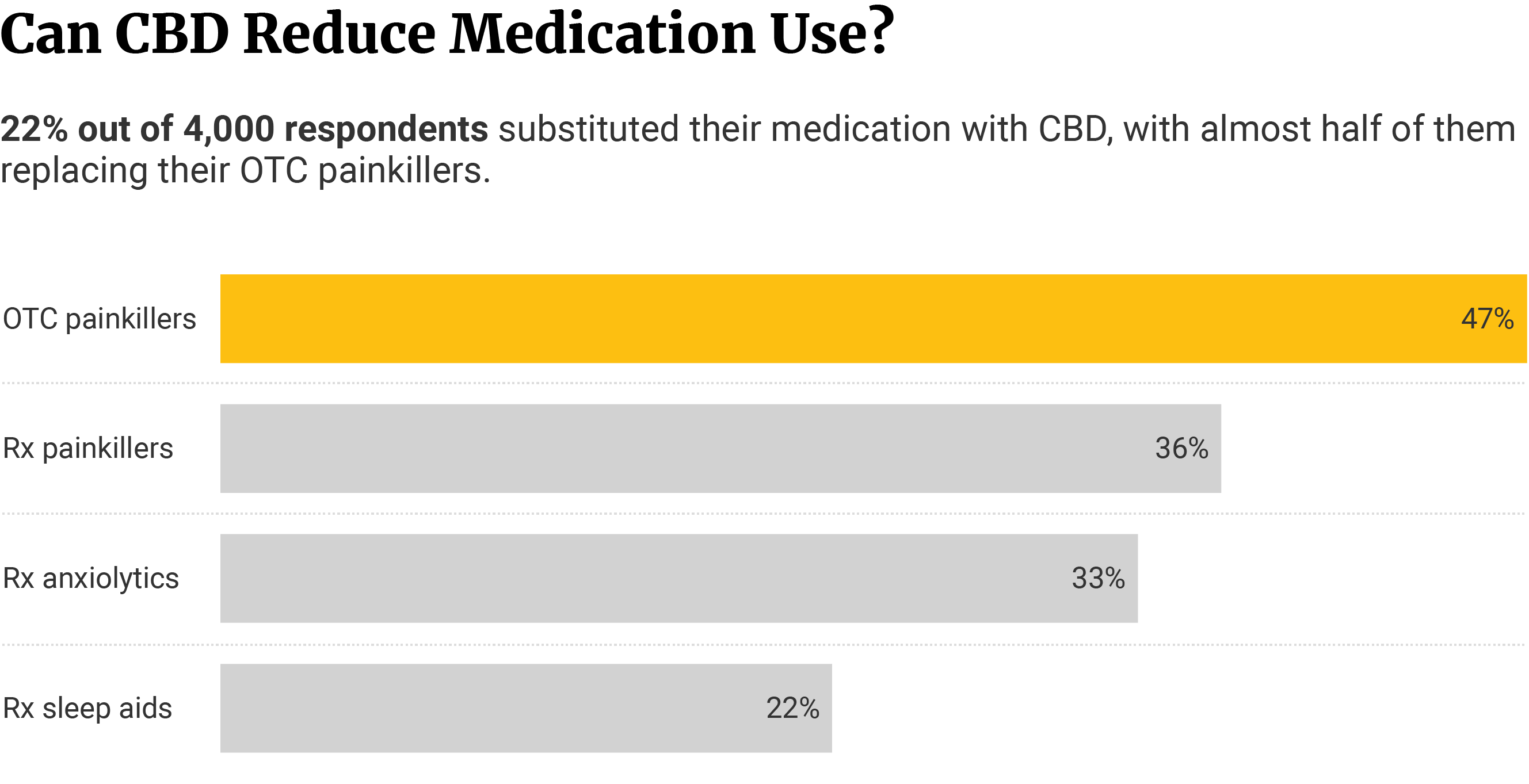
Does CBD Have Side Effects?
74% of CBD users say they did not experience any side effects. On the other hand, 26% developed some adverse reactions [27].

CBD statistics show that dry mouth appears to be the most common side effect associated with CBD use, affecting 11.12% of CBD users [21].
Sleepiness or grogginess, on the other hand, is the least common side effect, affecting only 1.78% of CBD users [21].
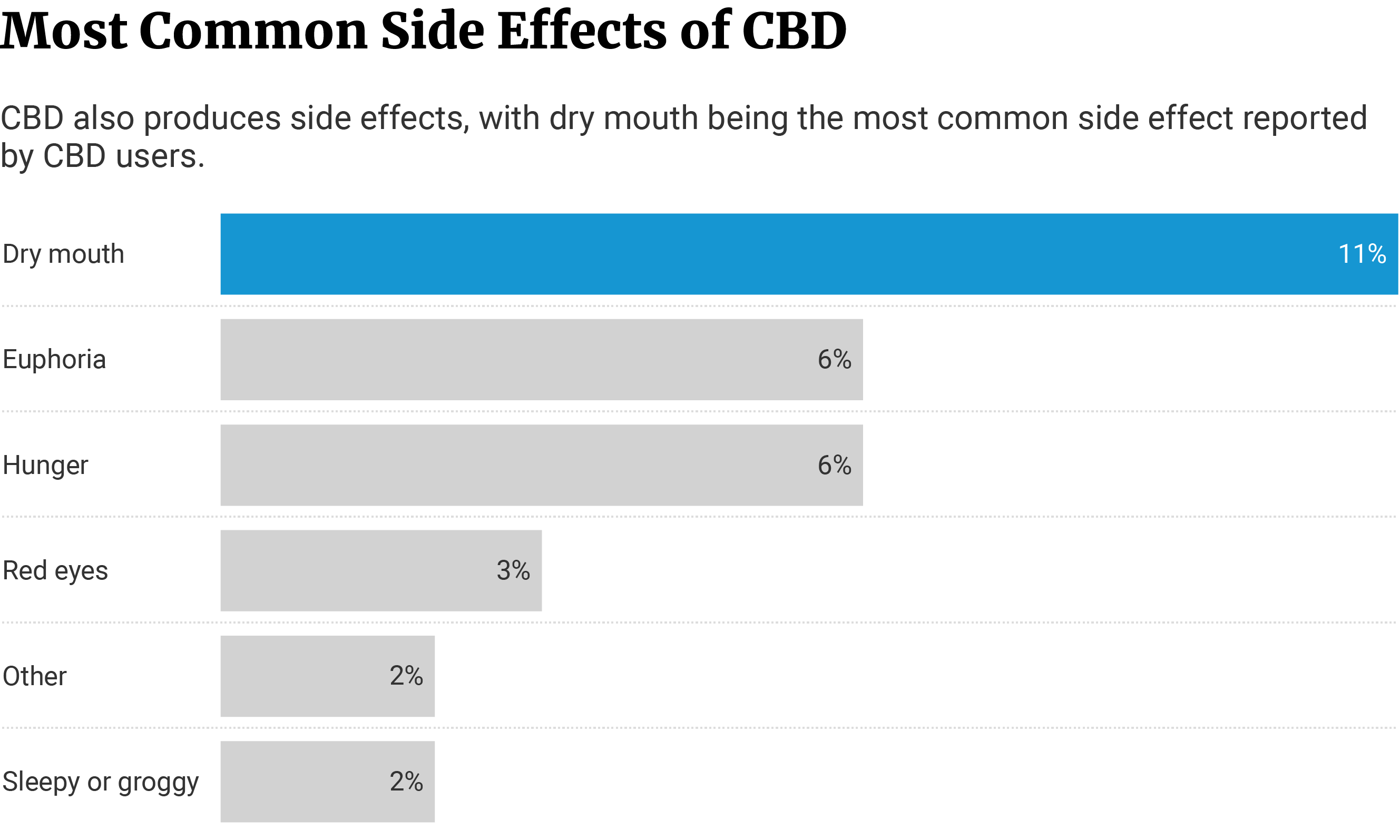
Why are Some People Hesitant to Try CBD?
30% out of the 1,500+ respondents in a 2021 survey say they found no CBD products that appealed to them [17].
23% or nearly 1 in 4 say they aren’t familiar with CBD, while 20% or 1 in 5 are wary of using CBD [17].
16% of the respondents find CBD expensive, while 13% are worried about CBD side effects [17].
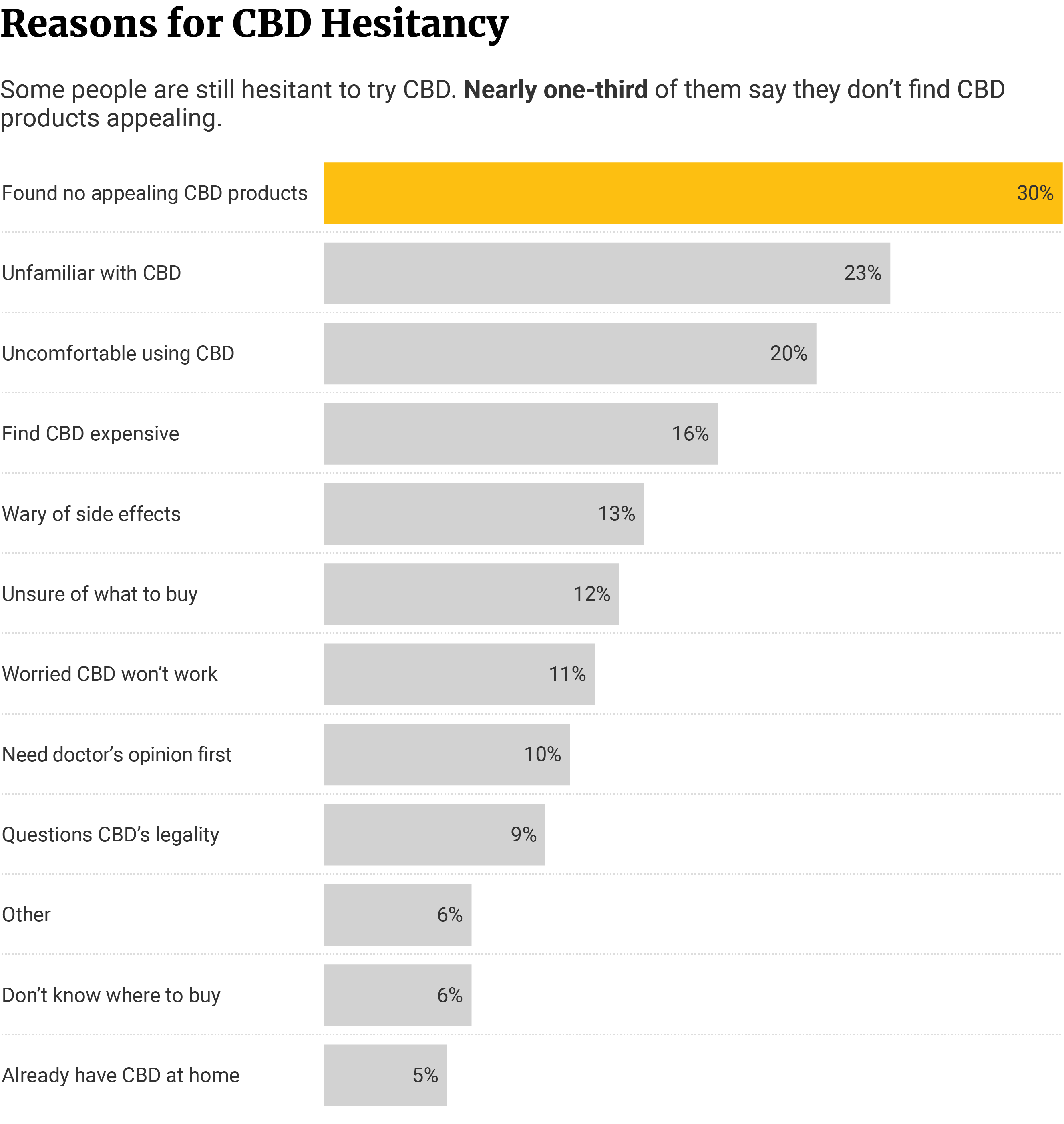
How Many People Use CBD?
26% of American adults are using CBD in 2022. This percentage has increased from 6% in 2018 [12].
By 2024, the percentage of CBD users in the US is projected to increase to 35% [12].
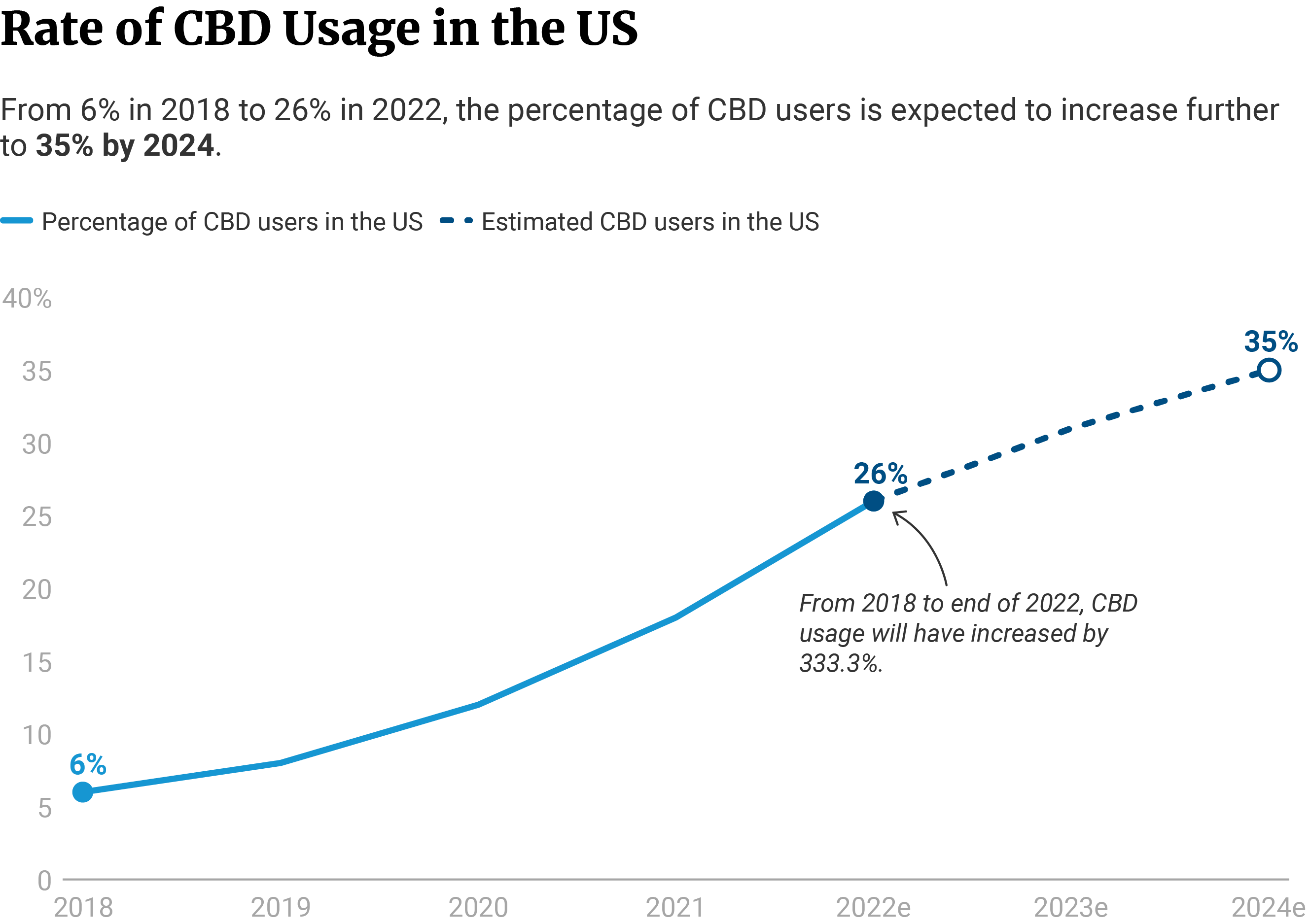
64 million Americans have tried CBD in the past 24 months, and 26% of them have tried CBD within the past couple of years at least once [27].
More than one-fourth of the US population uses CBD, with 1 in 7 adults using CBD daily [27].

CBD Consumer Demographics: Who Uses CBD the Most?
10% of men and 4% of women use CBD [32].
20% of young adults between 18 and 29 years use CBD [8].
Who Uses CBD the Most Between Women and Men?
21% of American men have tried CBD, compared to 16% of American women [32].
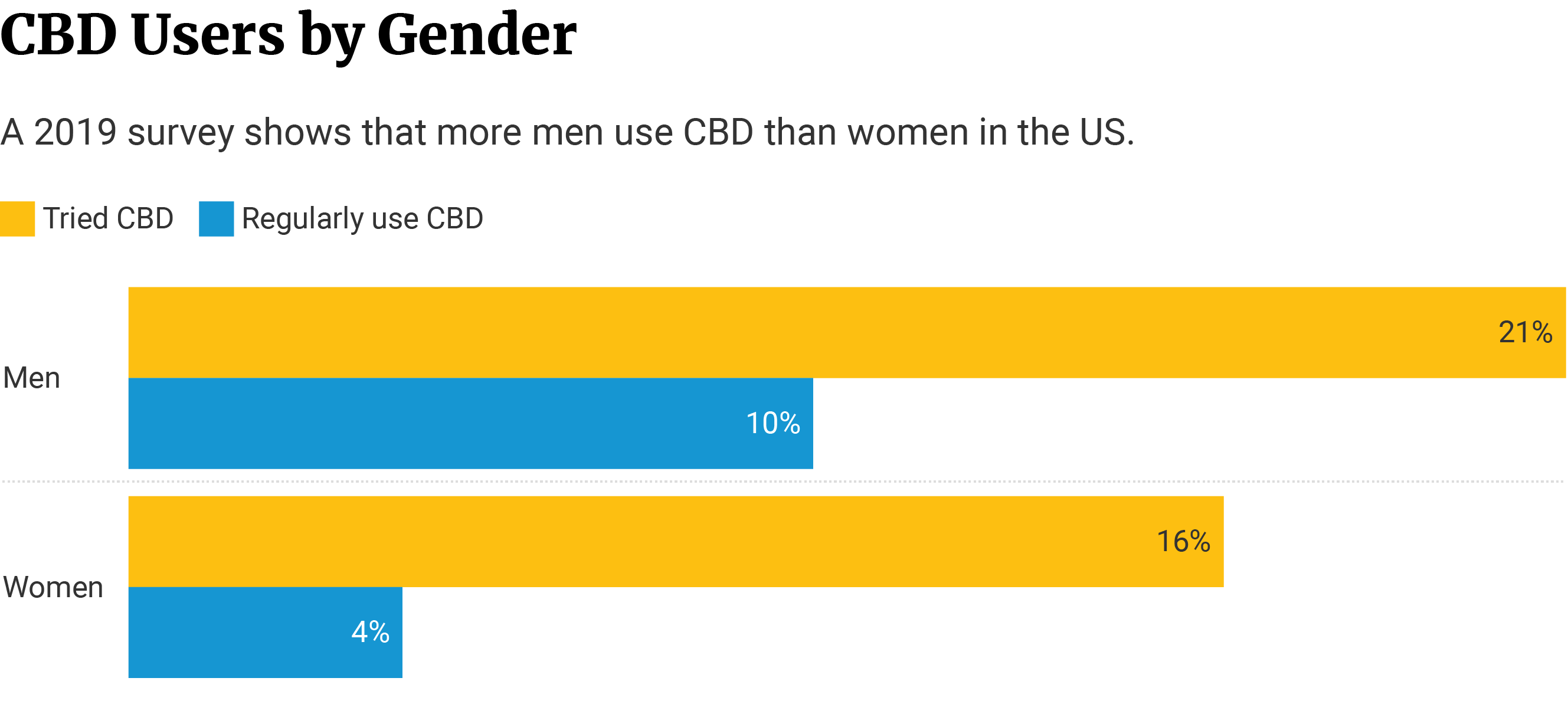
When it comes to regular CBD use, 10% of men regularly use CBD, compared to 4% of women [32].
CBD usage statistics also show that women tend to use CBD more for health reasons [32].
56% of women use CBD for relaxation, compared to 53% of men [32].
More women also use CBD for mental wellness. 53% of them use it for stress and anxiety, compared to 47% of men [32].
42% of women and 36% of men use CBD for chronic pain [32].
Men, on the other hand, use CBD more for social and spiritual purposes.
28% of men use CBD for social reasons, compared to women at 15% [32].
16% of men also use CBD for spiritual purposes. Only 9% of women use CBD for the same purpose [32].
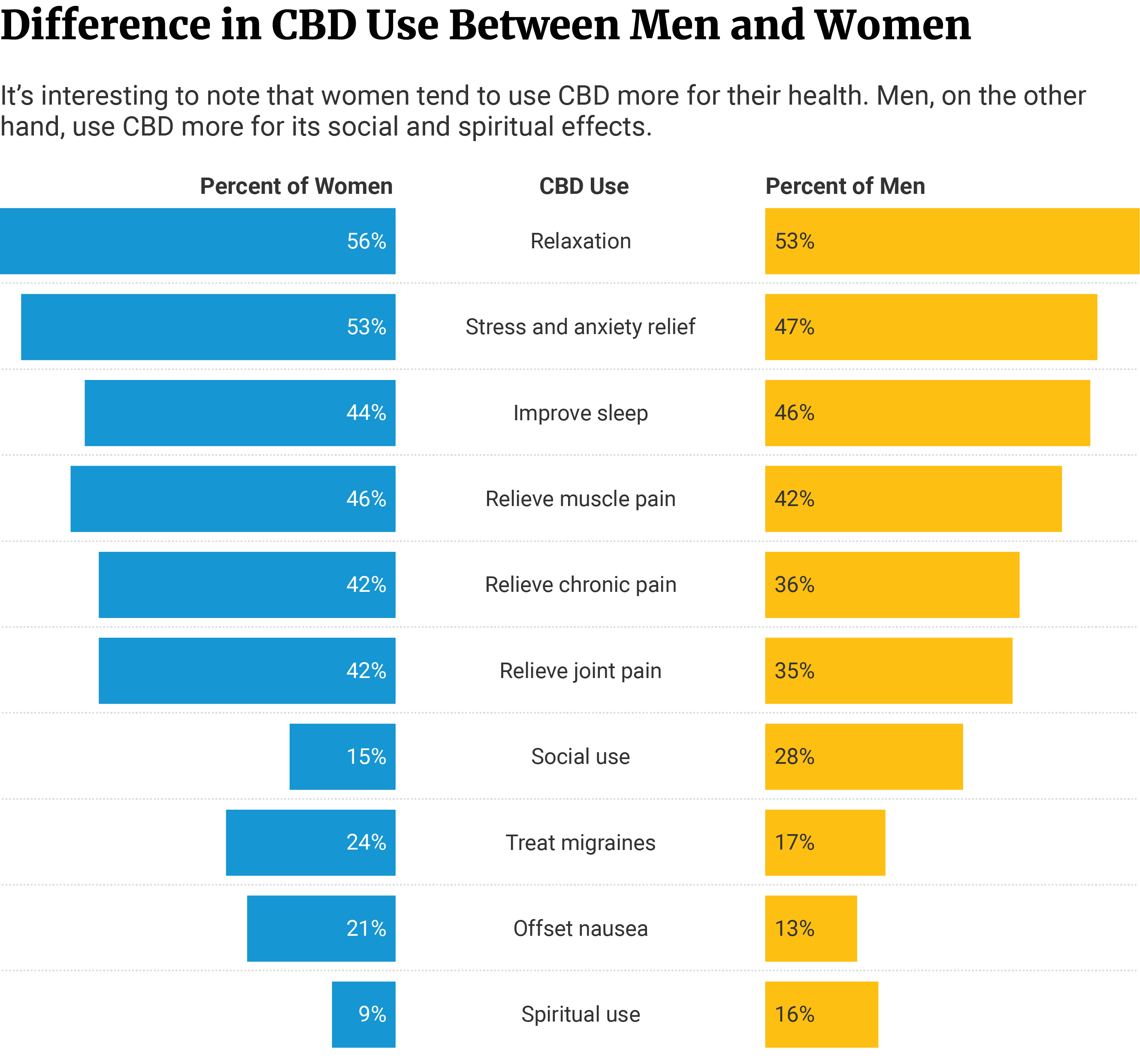
What Age Group Uses CBD the Most?
20% of young adults between the ages of 18 and 29 years use CBD. They’re the age group that’s most familiar with CBD and also uses it the most. Of this age group’s population, only 26% of them aren’t familiar with CBD products [8].
As the age increases, you’ll also notice a decrease in the percentage of CBD usage and familiarity.
The age group that uses CBD the least is older adults (65 years and above). Only 8% of them use CBD, and almost half of their population (49%) are not familiar with CBD products [8].
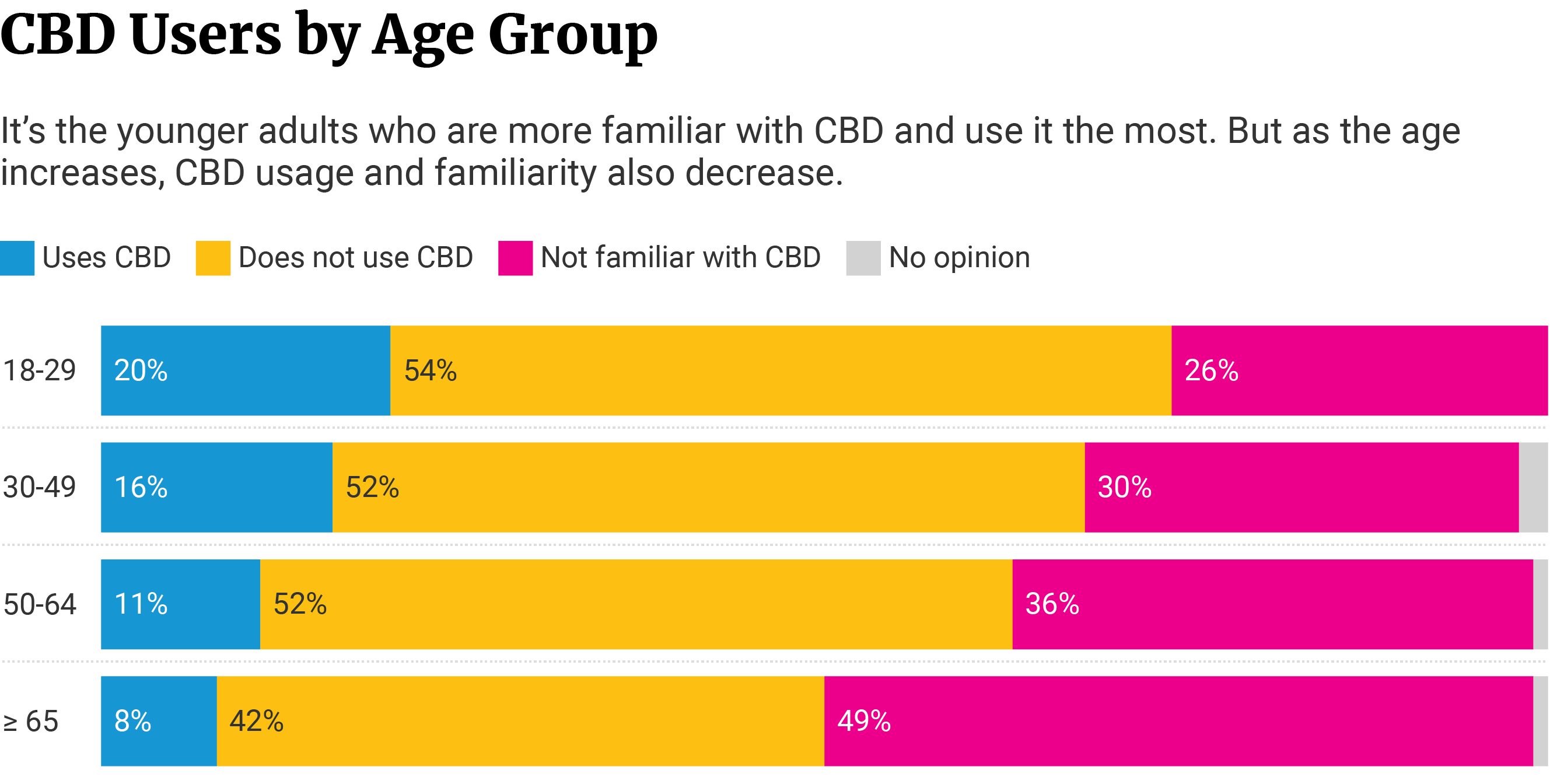
40% of young adults between the ages of 18 and 29 years old have tried CBD, compared to 15% of older adults (65 years and above) [27].

Of the different generations, it’s the Gen Z population that uses CBD regularly or occasionally at 11%. Only 4% of the Boomers use CBD [13].
- Gen Z: 11%
- Millennials: 9%
- Gen X: 7%
- Boomers: 4%
What Race Uses CBD the Most?
64% of CBD users are Caucasian. The ethnicity that uses CBD the least is Asian/Asian Americans. They only make up 4% of the total CBD users in the US [47].
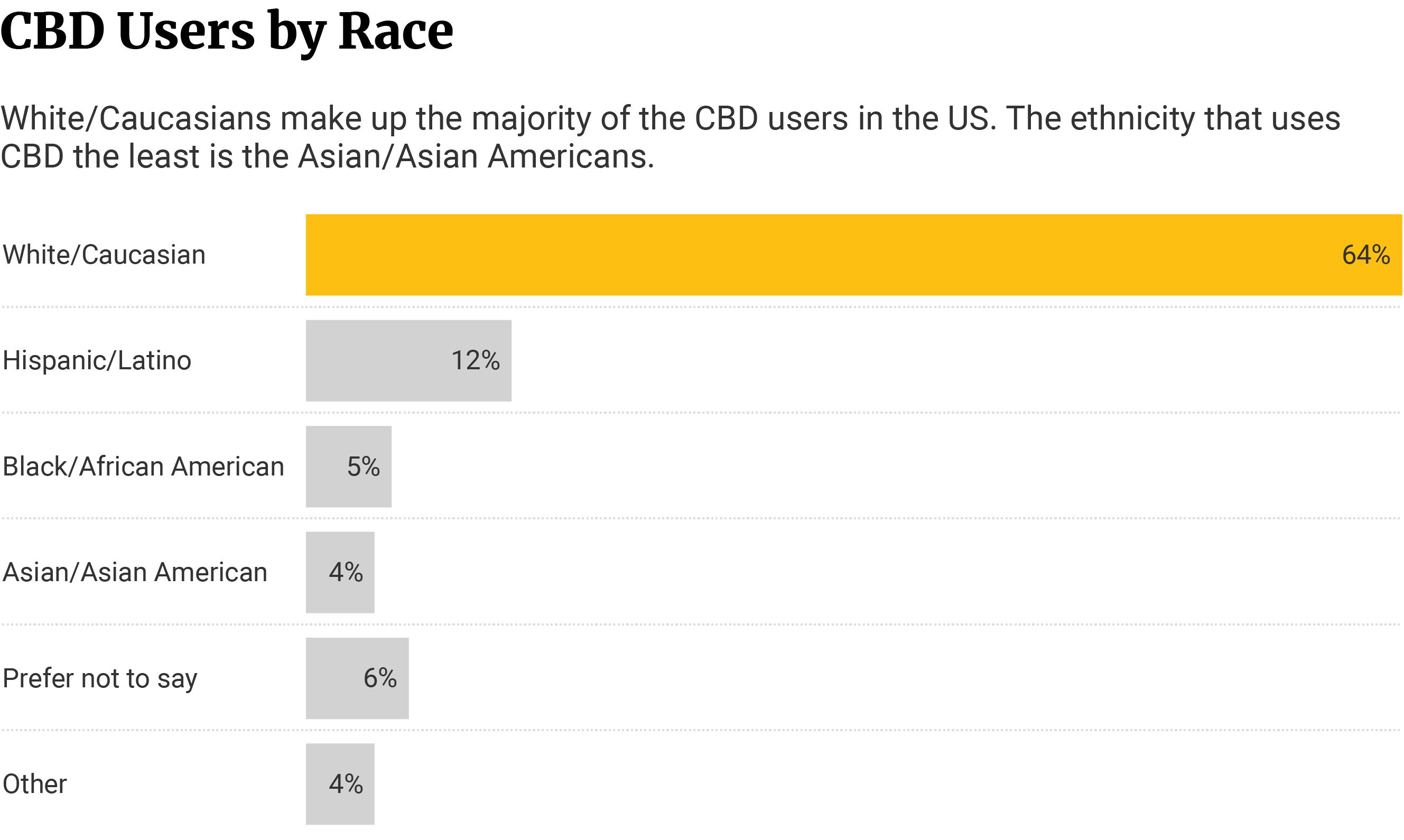
Which States Consume the Most CBD?
California consumed the most CBD, with sales reaching $730 million in 2019. Florida and New York follow in second and third places at $291 million and $215 million, respectively [14].
States that had less than $23 million in CBD sales made up a combined $941 million [14].
Factors that could influence the CBD sales of a state include:
- Population
- Number of dispensaries
- Growth of chain dispensaries
- Increasing professionalism in the industry
- An increasing number of investors

By 2024, these numbers are expected to increase, with California’s CBD market becoming a $3.32-billion industry [15].
Florida’s CBD market is also expected to reach $1.81 billion. New York follows at $1.55 billion [15].
States with the lowest CBD markets by 2024 are Connecticut with $0.26 billion as well as Indiana and Tennessee with $0.28 billion each [15].
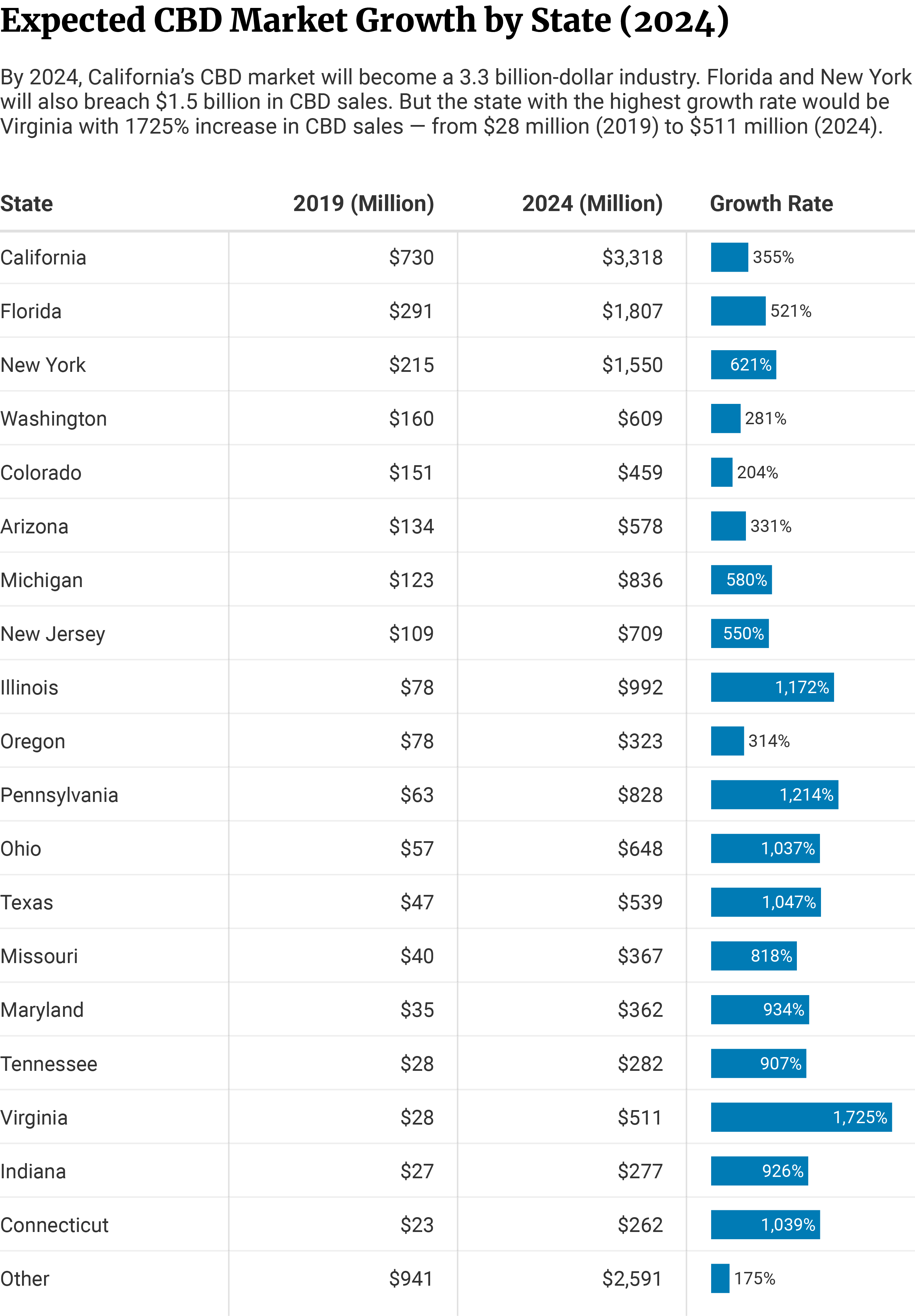
CBD Statistics By Region
21% of those who reside in Western states consume CBD. The regions that consume the least CBD are the Eastern and Midwestern regions at 11% each [8].
58% or more than half of the Midwestern regions don’t use CBD [8].
39% or about one-fourth of the Eastern region are not familiar with CBD products [8].
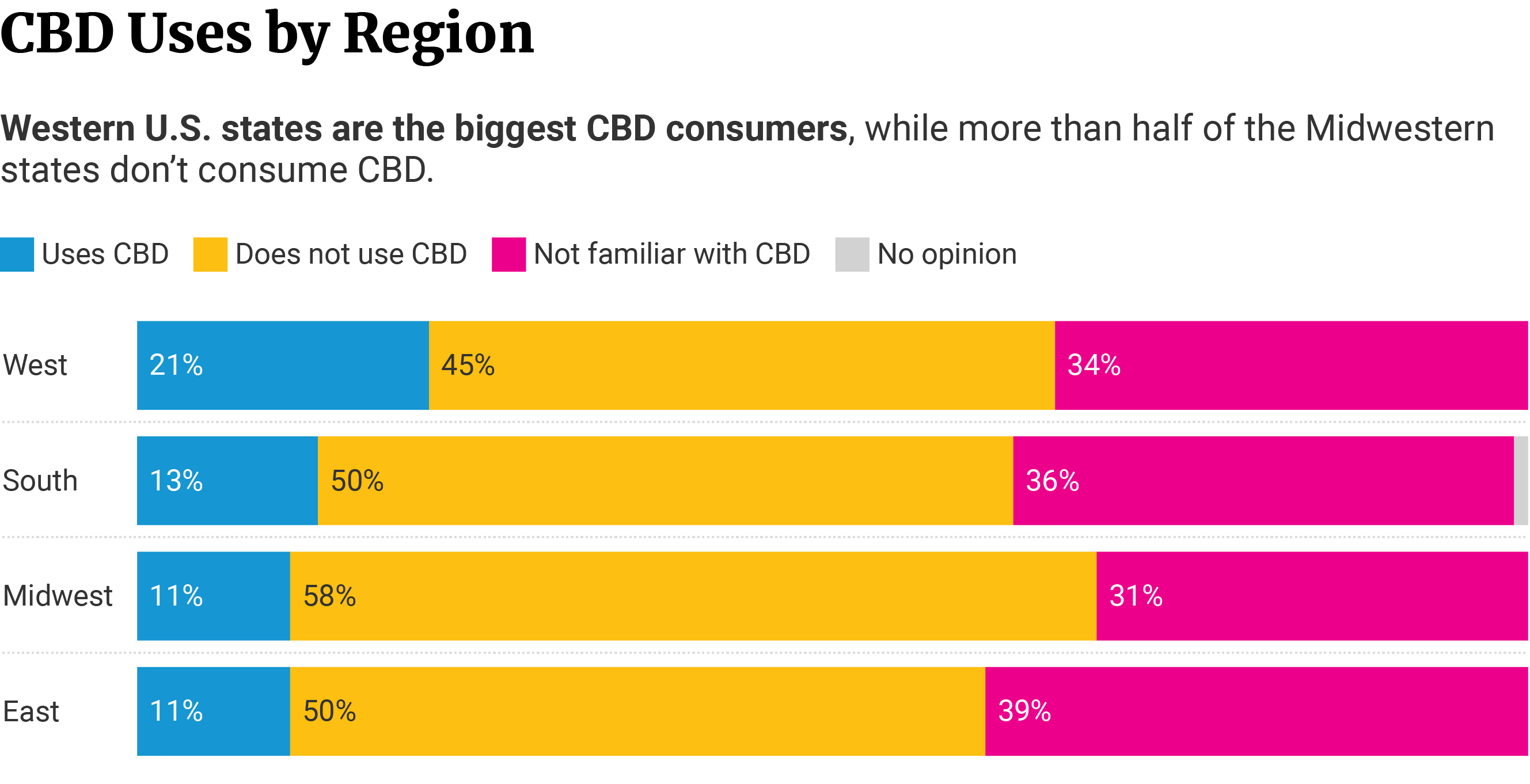
CBD Oil for Dogs and Pets Statistics: Is CBD Good for Pets?
CBD benefits our pets and 50% of pet owners in the US use it for their animals [45].
31% of pet owners have replaced their pets’ prescription medications with CBD. They find that hemp-derived CBD products are not only beneficial but safe for their pets [54].
77% of pet owners who purchase CBD products use it for their dogs, while 21% use CBD for their cats [54].

Dog owners are also more likely to use hemp-derived CBD for the following conditions than cat owners [54]:
- 48% of dog owners use it for anxiety reduction.
- 34% use CBD to improve their dog’s mood.
- 20% of them also use it for skin conditions.
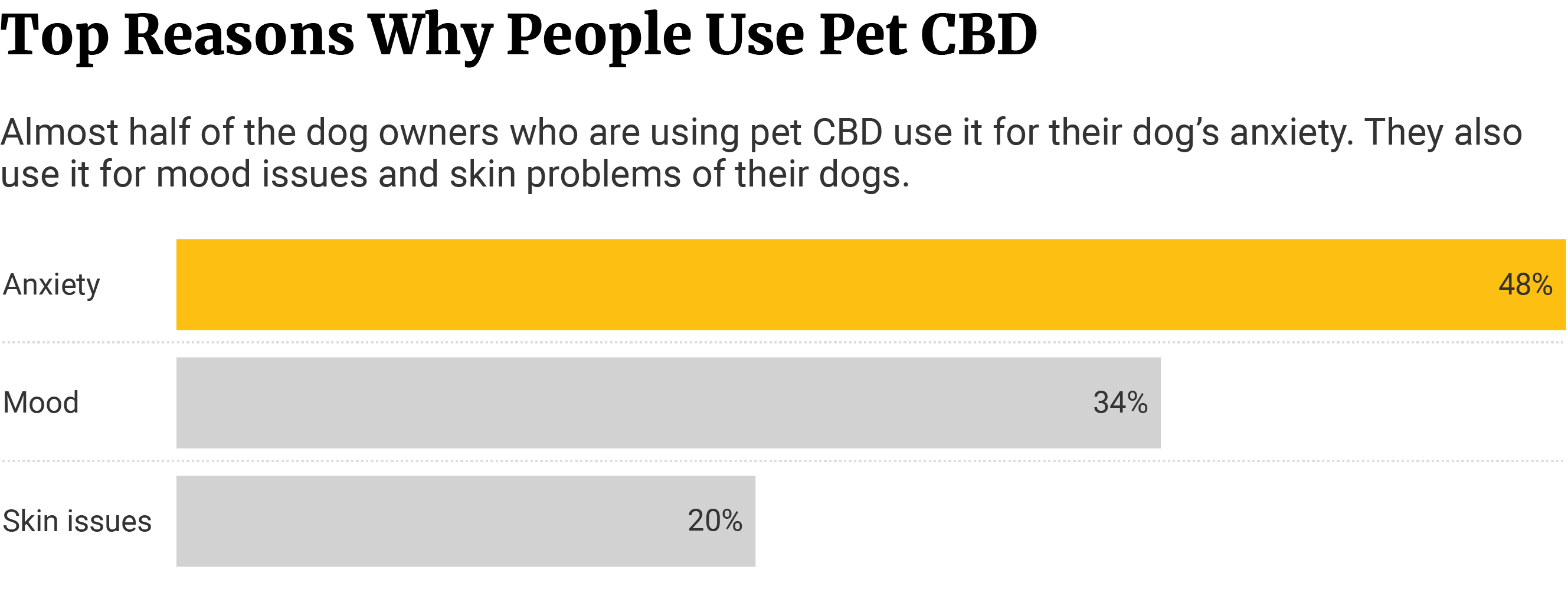
Is CBD Effective for Pets?
90% of pet owners who use hemp-derived CBD products for pets are happy with the results and say the products are effective in improving their pet’s life [54].
58% of them say CBD made their pets calmer [54].
46% say CBD improved their pets’ sleep, while 41% say their pets’ mobility improved on CBD [54].
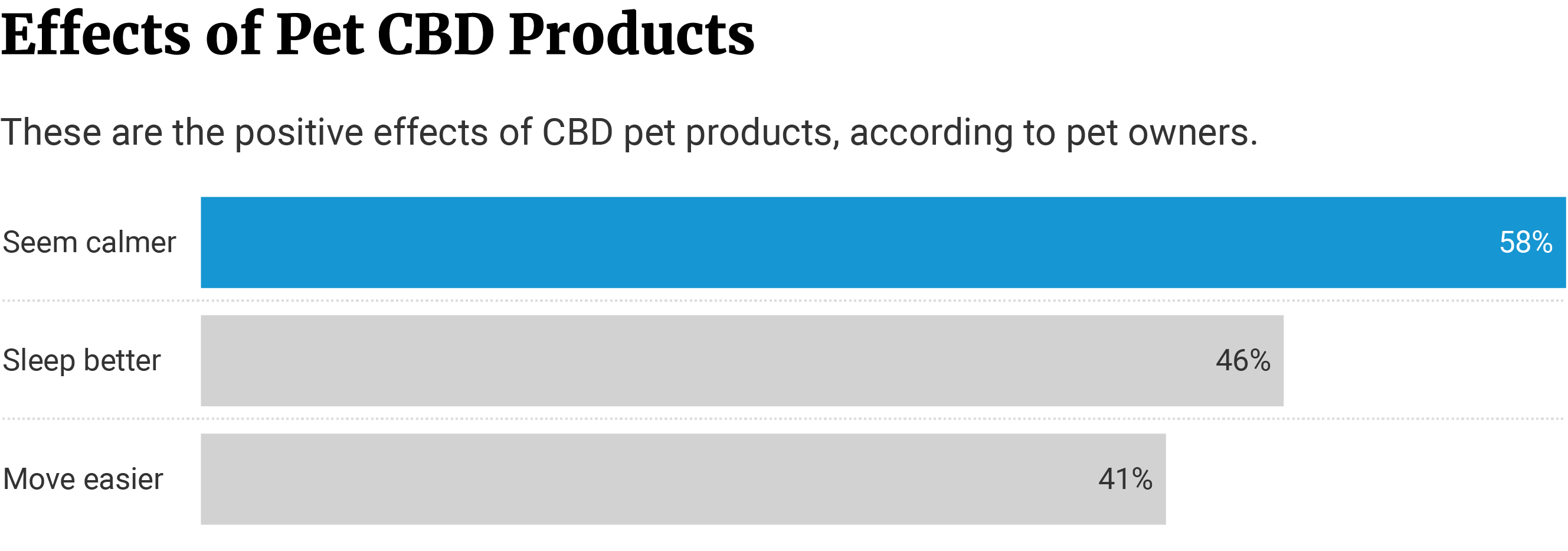
90% of pet owners agree that vets should be allowed to prescribe CBD. These pet owners either purchase CBD or are open to buying pet CBD [54].
Does CBD Work for Dogs and Cats?
CBD works for dogs and cats and 9 out of 10, or 90.91% of pet owners, say they will recommend CBD to other pet owners [7].
Only 1 out of 10, or 9.09%, said they wouldn’t recommend CBD to other pet owners [7].
63% said that they’ve tried other medications on their pets before trying CBD [7].
- 83% of them say CBD was more effective than the other medications.
- 81% say CBD was safer for their pets.
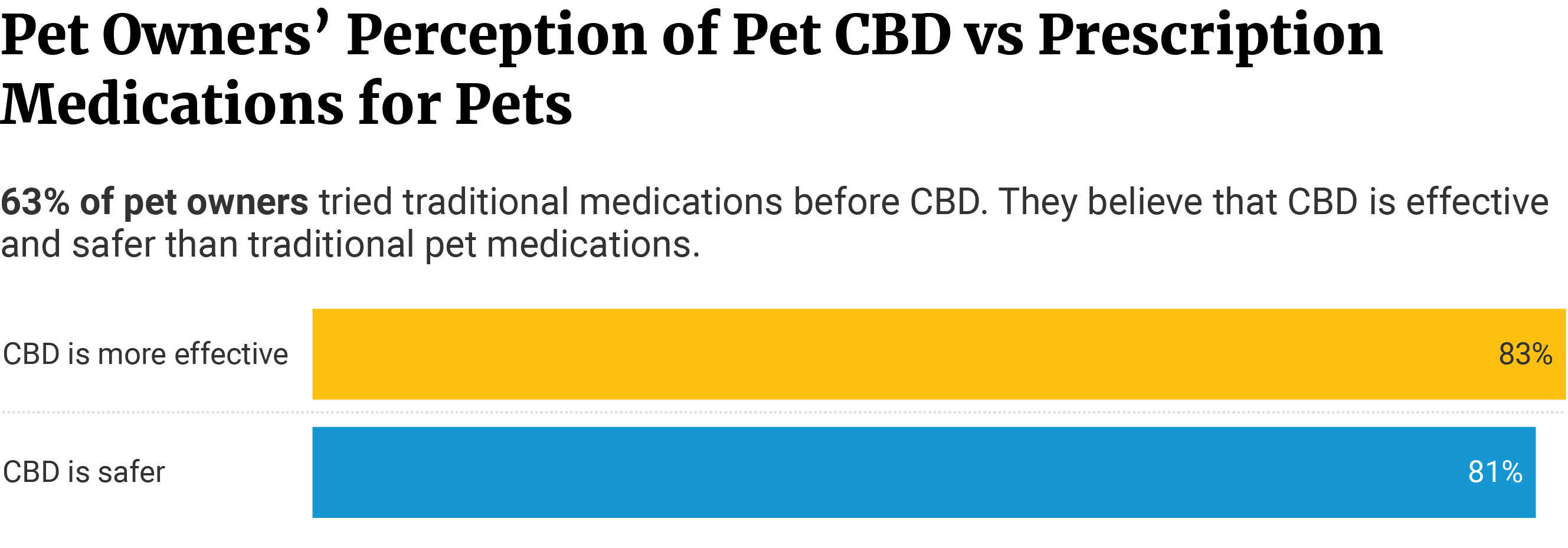
What Type of CBD is Best for Dogs and Cats?
48% of pet owners give hemp-derived CBD pet edibles. Not only is it easier to administer, but it also comes in different flavors that pets usually enjoy [5].
A small percentage (7%) doesn’t mind what the product is as long as it contains CBD [5].
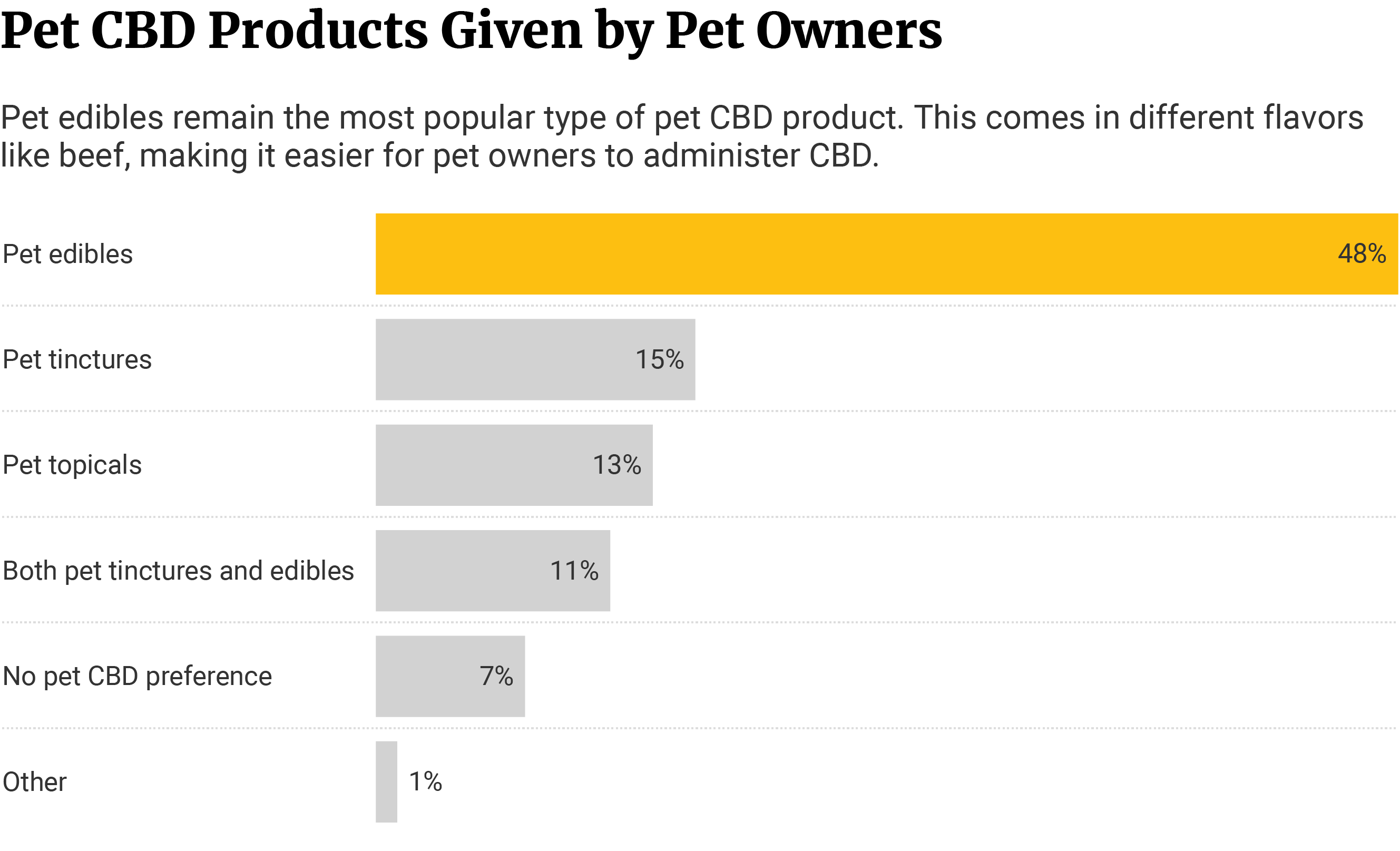
How Do Vets Feel About CBD for Dogs?
35.12% of vets recommend using CBD for pets [7].
Only 6.06% are against pet CBD products [7].
While the majority of vets know of pet CBD products, a small percentage (0.89%) still don’t know about CBD for pets [7].
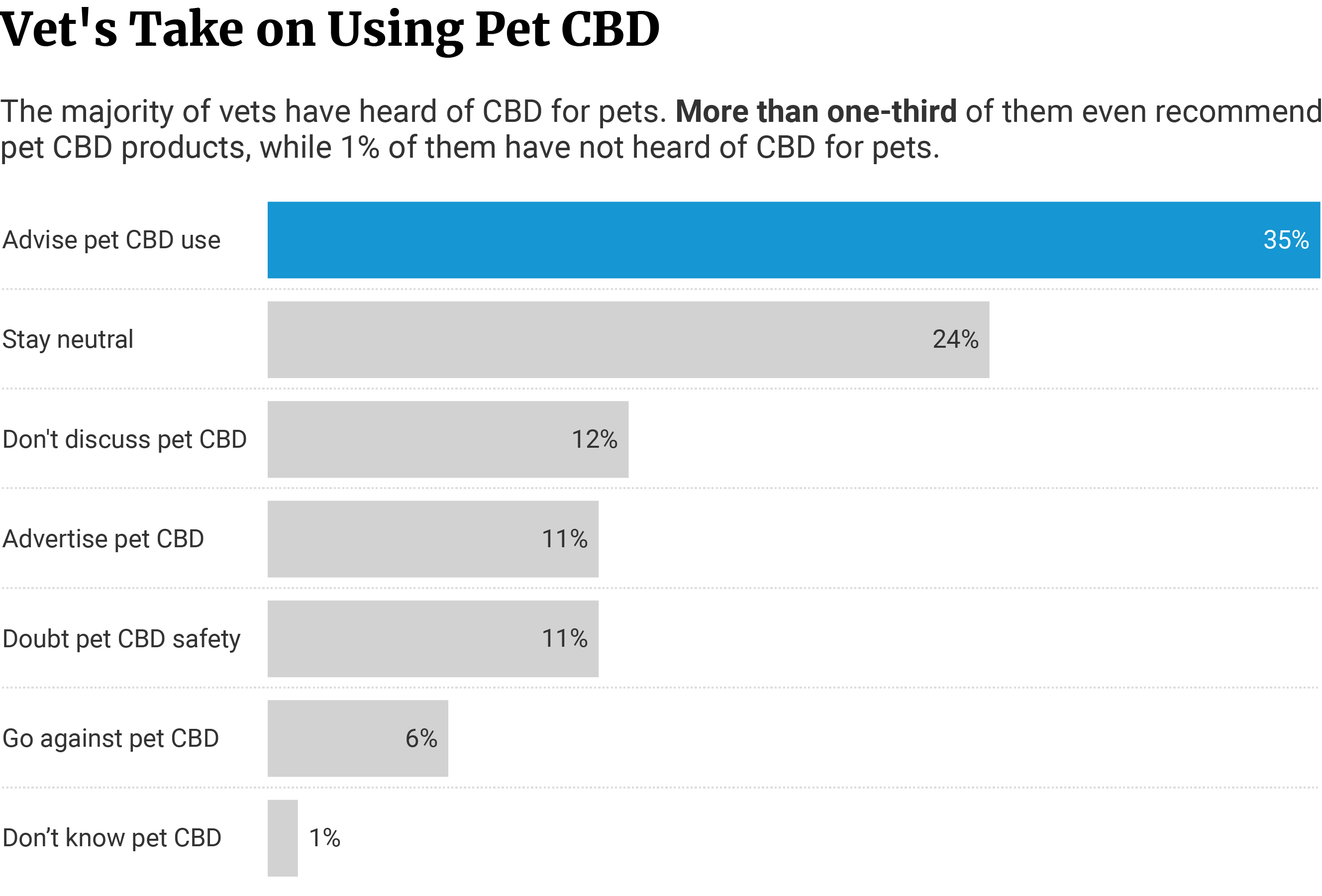
CBD Statistics by Product Type: What CBD Products Sell the Most?
CBD tinctures sold the most in 2021 at $976.07 million. The CBD product that sold the least was pre-roll or flower at $64.97 million [20].
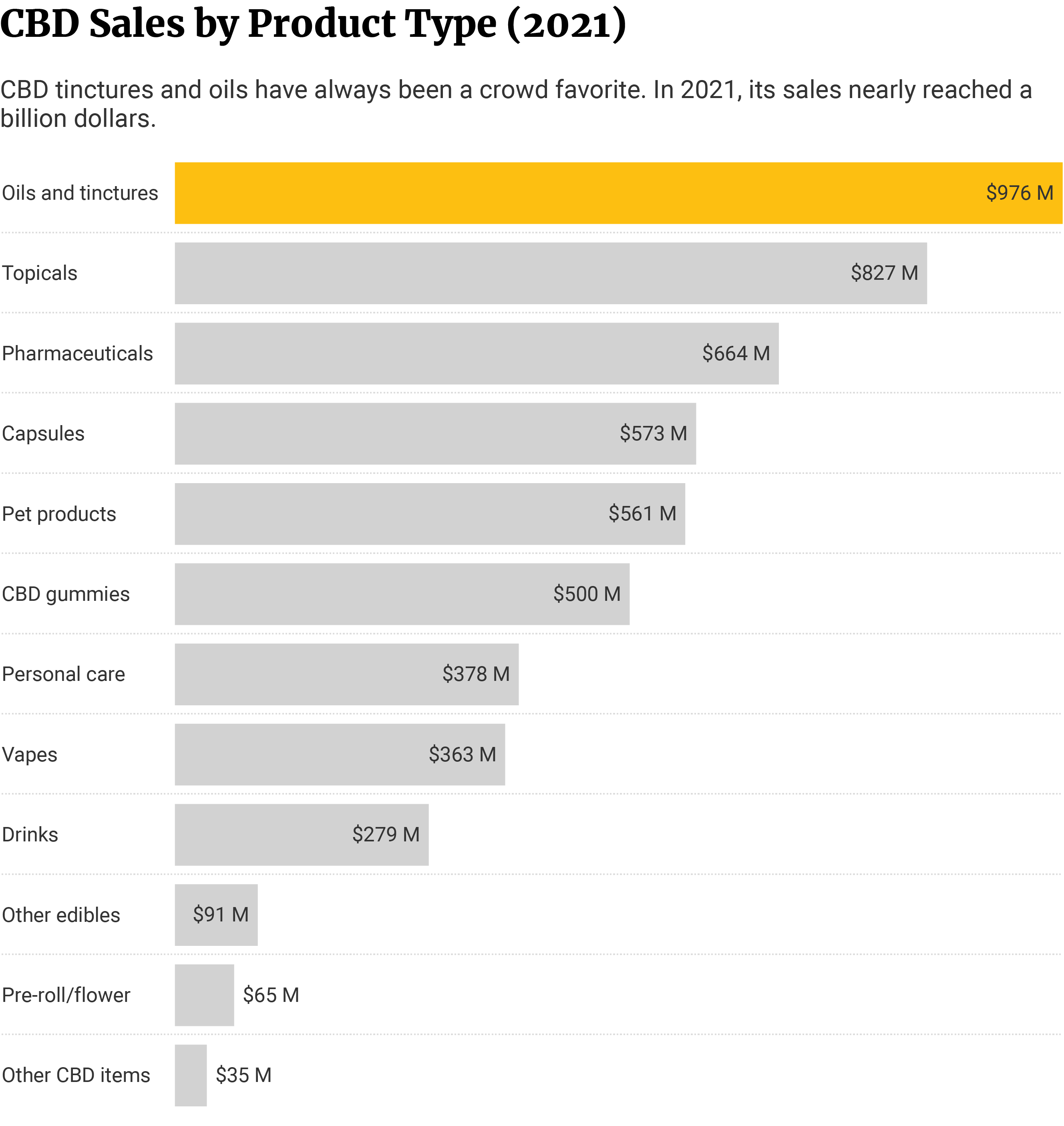
We can see some changes in consumer preferences from 2019 to 2021 as the COVID-19 pandemic spread in the US.
In 2019, CBD extracts were the most popular, with 48% of CBD consumers using such products [52].
Vape pen — which is a favorite of young adults — came in second place, with 37% of CBD users using CBD vape pens [52].
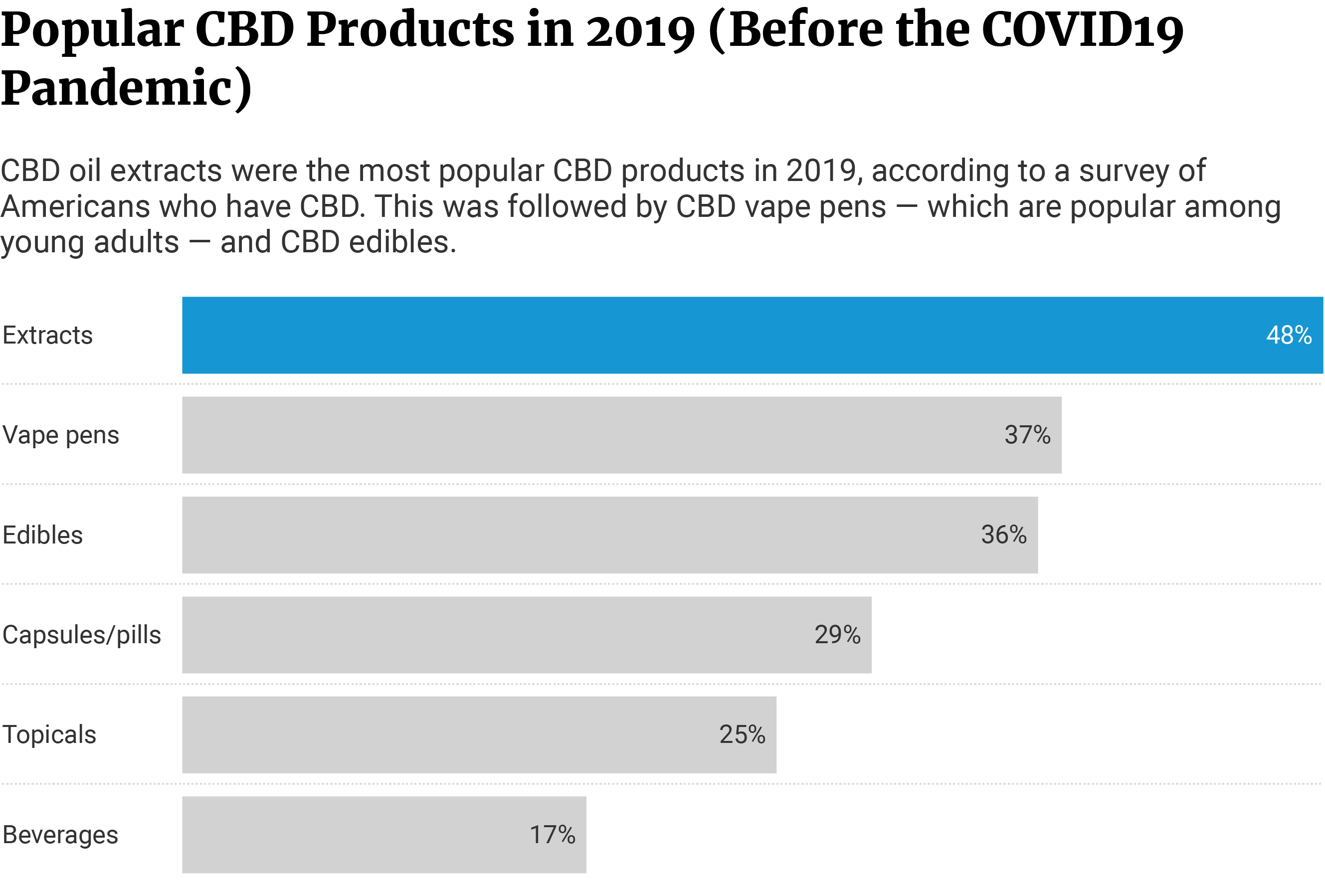
By 2020, CBD preferences had shifted as the pandemic began to spread.
29% of American adults were now more interested in CBD topicals like balms and lotions. CBD edibles and CBD extracts came in second and third places at 28% and 26%, respectively [40].
Vape products dropped to 7th place with 13% [40].
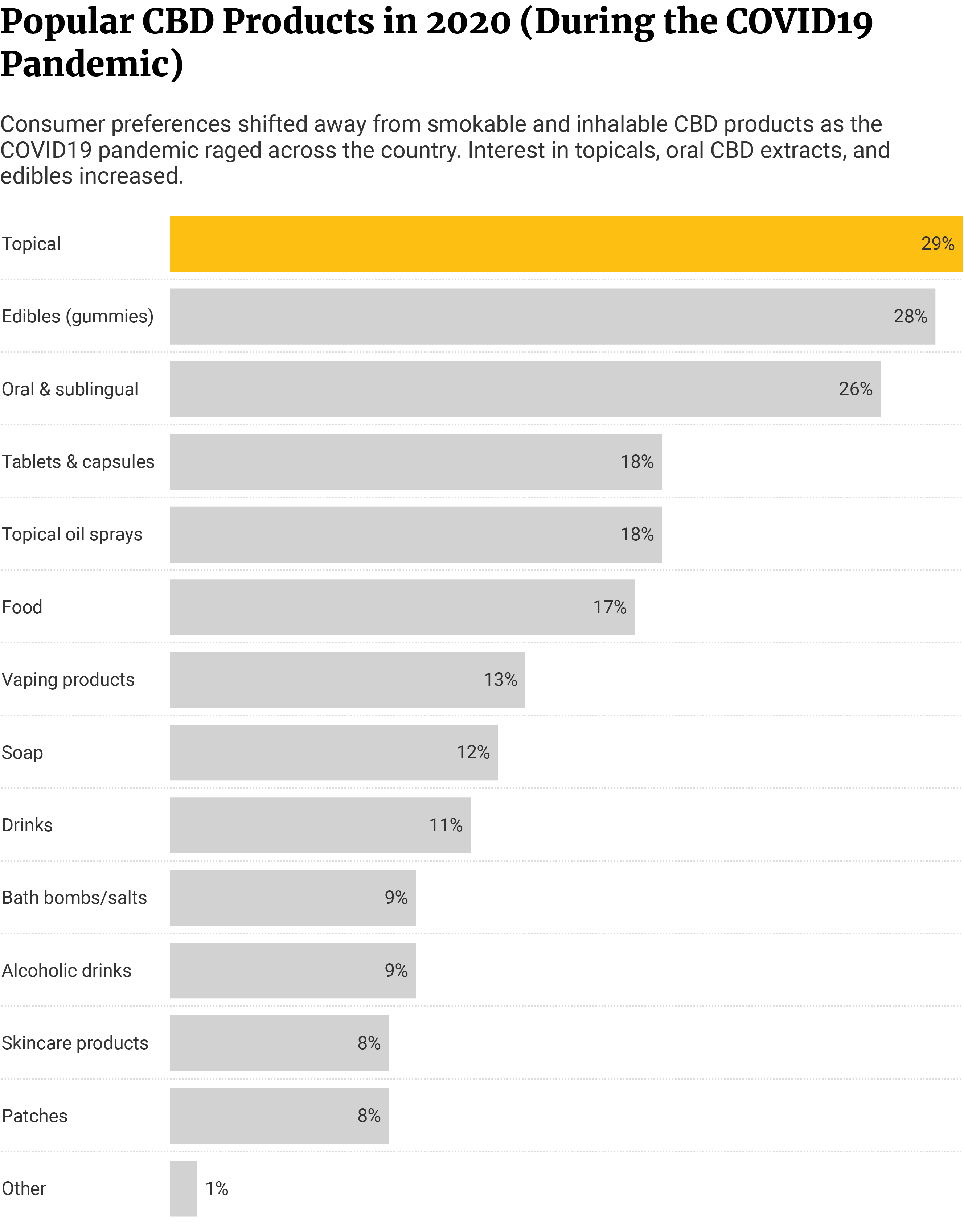
With the virus primarily affecting the lungs, CBD consumers shied away from smokable and inhalable CBD products. CBD oil consumption increased and interest also shifted to topicals, edibles, and oral CBD oils.
Is CBD Still Trending?
In 2014, the subreddit r/CBD only had 1,413 subscribers. By 2016, the subreddit’s subscribers had more than tripled to 5,504 [50].
The 100k mark was breached in 2020, with 116k members. By August 2022, its subscribers had grown to about 149k [50].
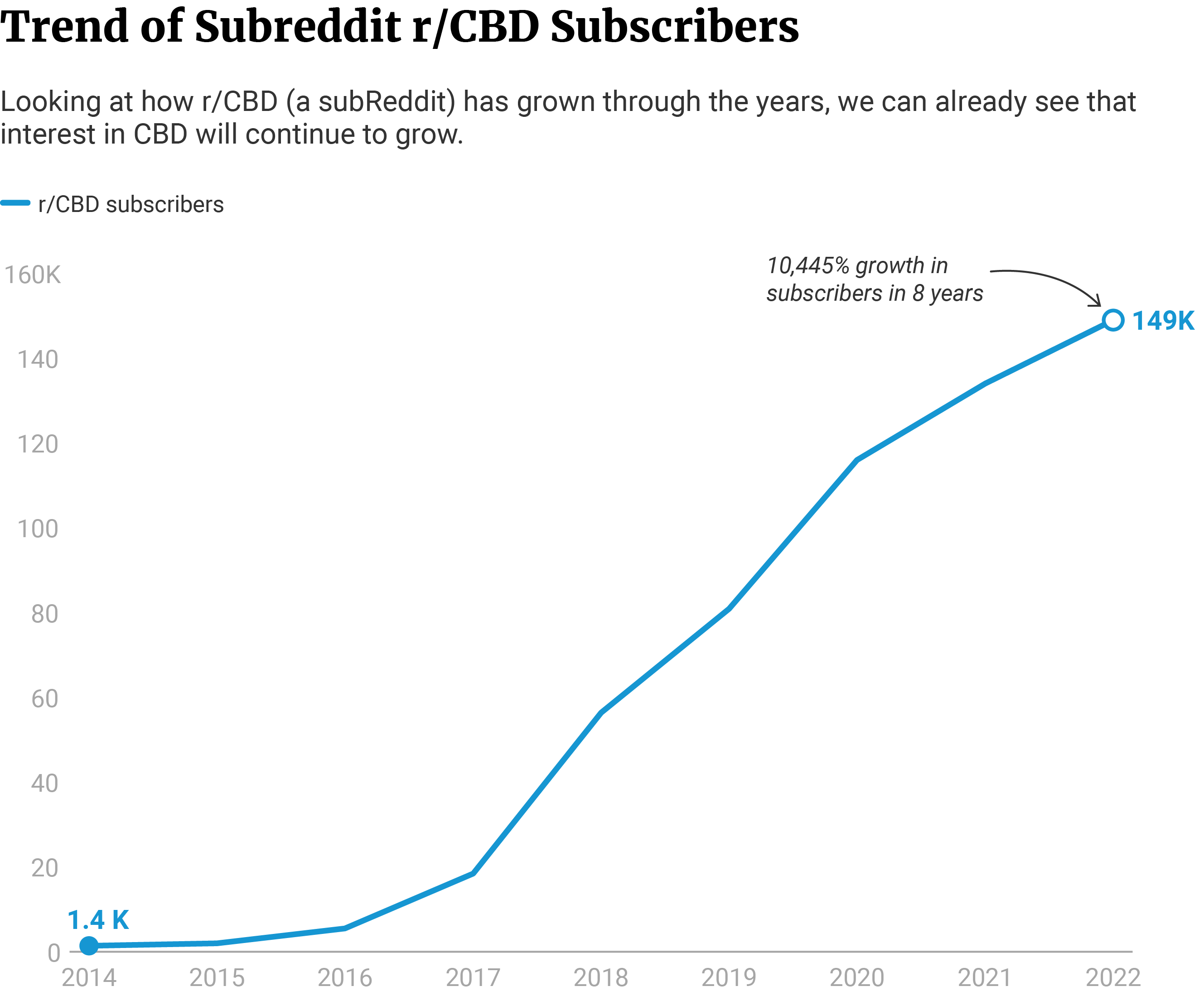
We can track CBD’s popularity increasing over the years by looking at the growth of this popular subreddit — r/CBD.
How Popular is CBD on Social Media?
38.04% of people say they learned about CBD through an internet search. This is only about 3 percentage points less than the 41.24% of people who learned about CBD from their family and friends [21].
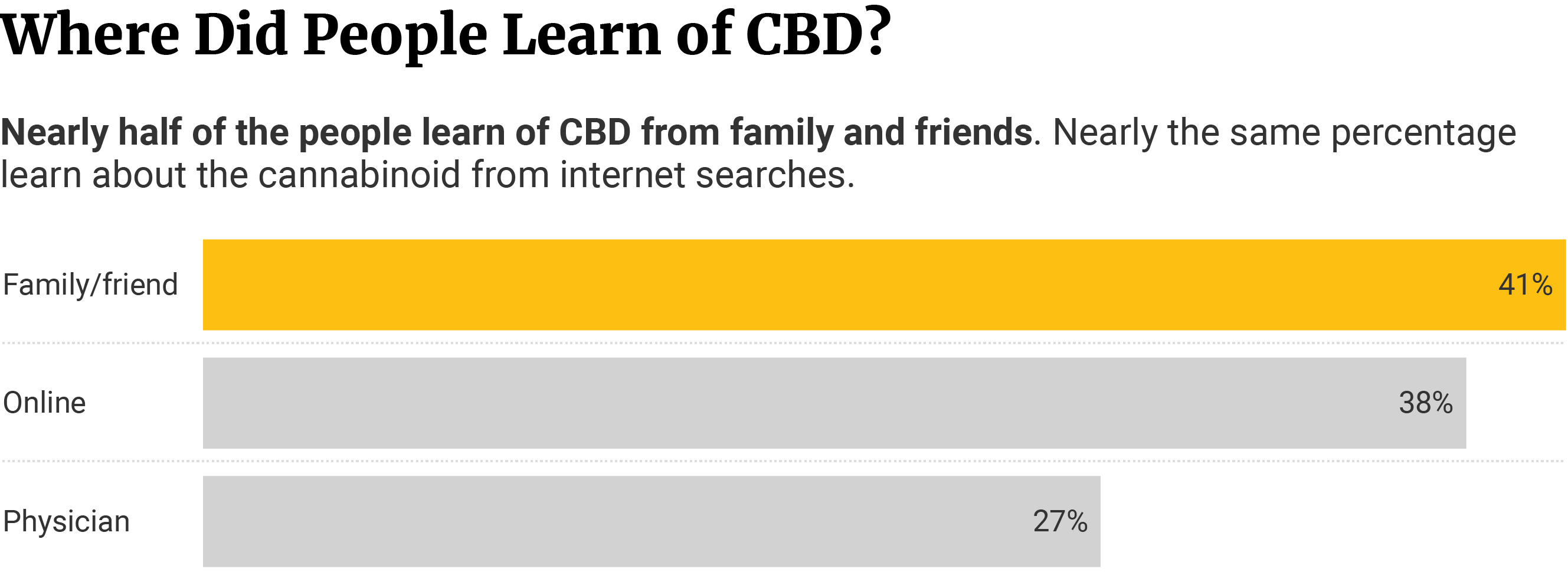
48.71% or almost half of online CBD discussions happen on Twitter [44].
Online forums like Reddit host one-fourth of online CBD talks at 25.05%, while YouTube contributes the least at 3.49% [44].
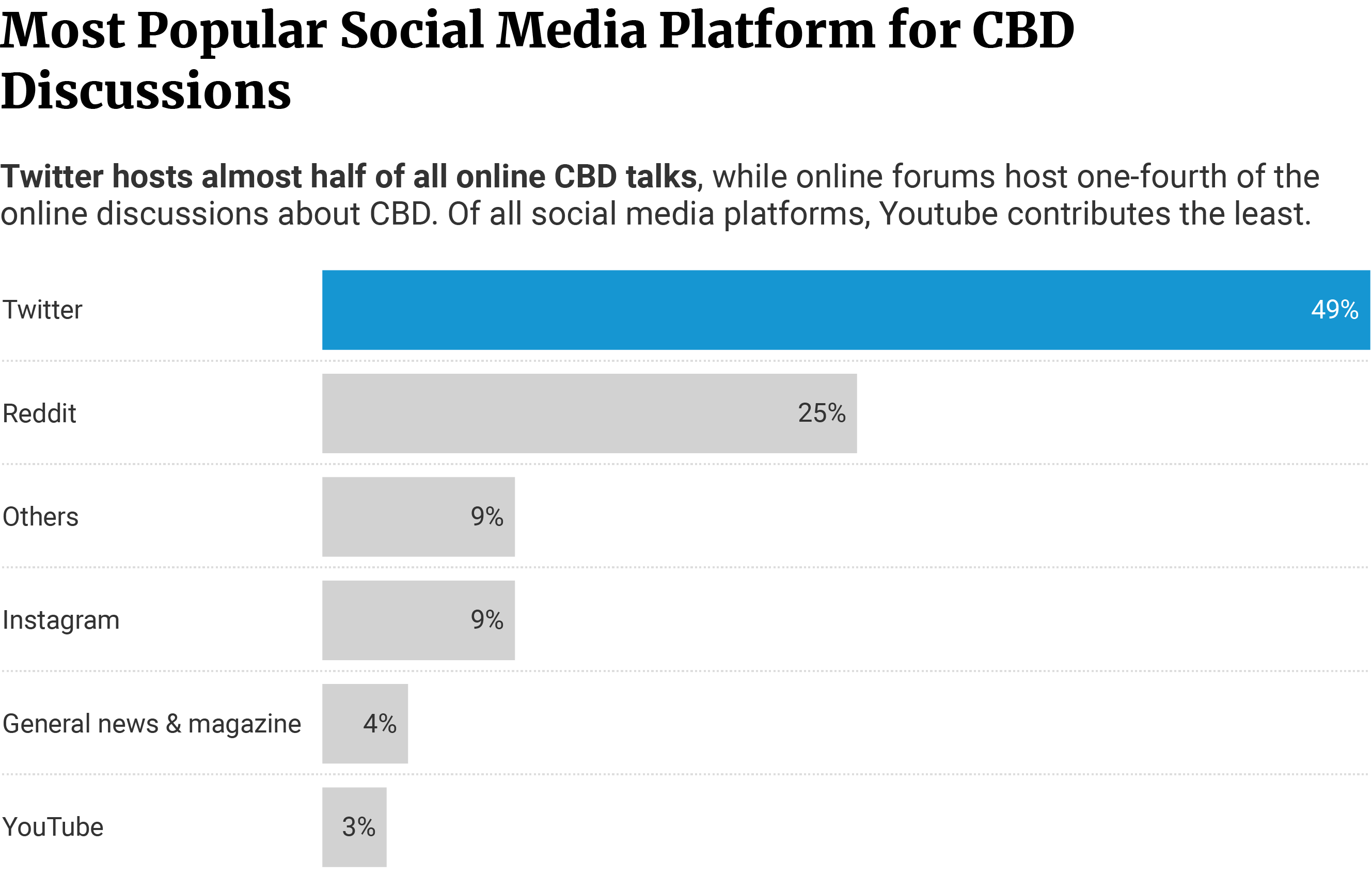
67.91% of online conversations about CBD revolve around sublingual CBD [44].
18.20% talk about inhalable CBD products, while 9.54% discuss oral CBD applications [44].
The least talked about CBD topics online is topical CBD application with only 4.34% [44].

Online shops make up the second most common CBD outlet, with 41% of CBD consumers buying online. This is only about 7 percentage points less than the 48% of people who bought CBD in specialty shops [48].
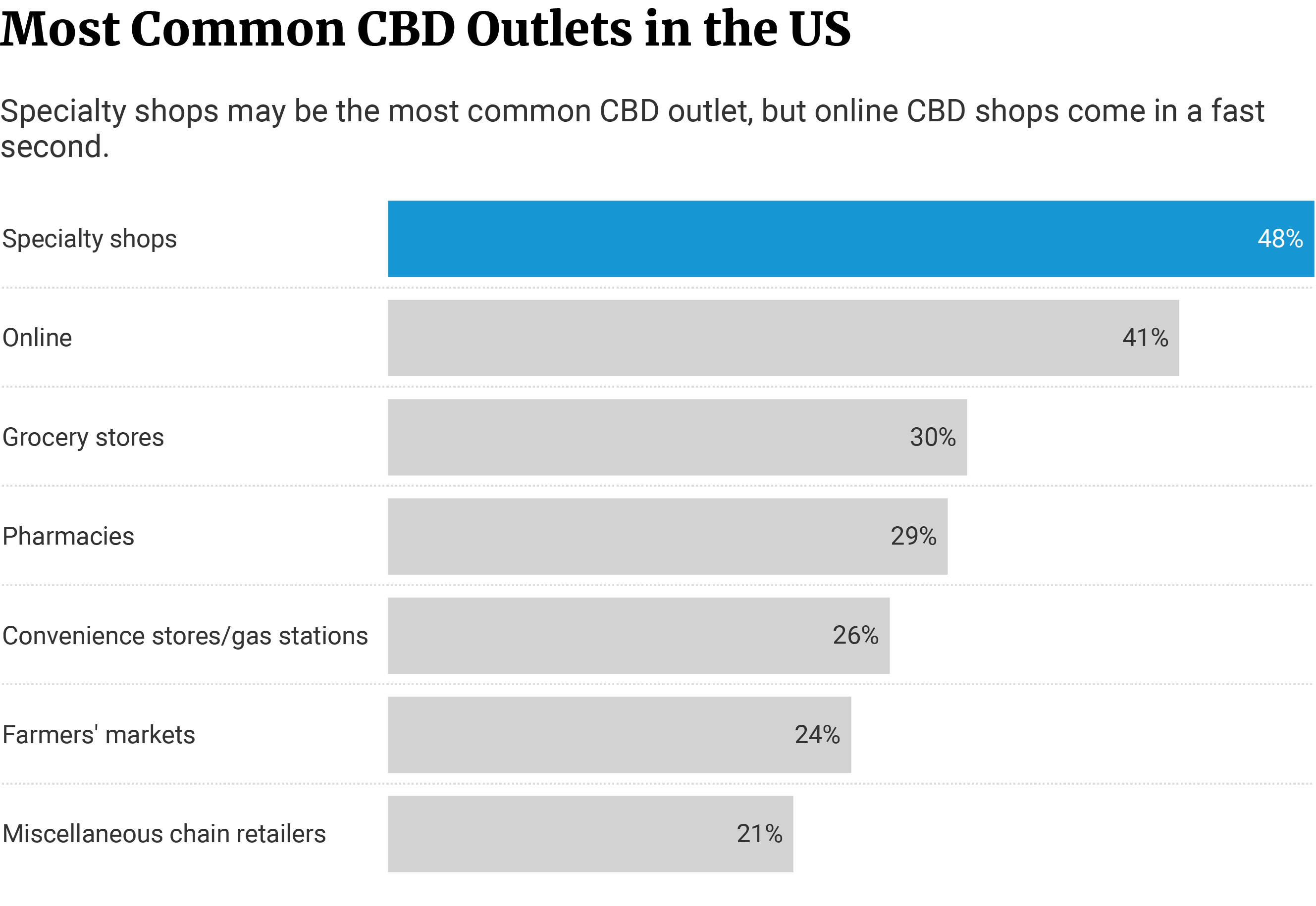
CBD Cost Statistics: How Much Money is Spent on CBD?
The market trend shows that $7.9 billion will be spent on CBD products by the end of 2022, increasing from 2019’s $4.15 billion [18].
If market trends stay true, the US will have spent $15.97 billion on CBD products by 2026 [18].
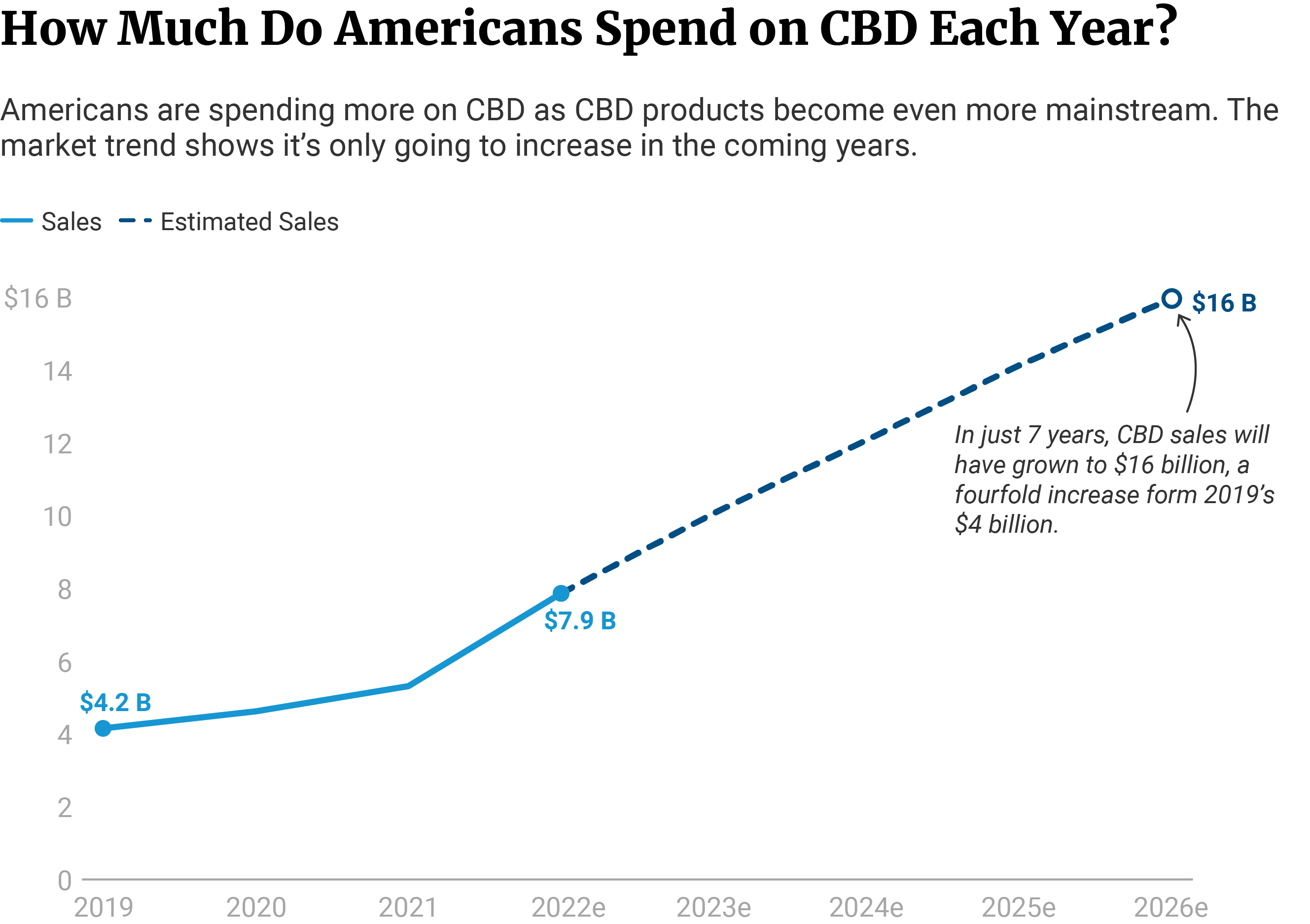
E-commerce generated the highest CBD sales at $2.02 billion in 2021 [19].
Pharmacies followed with $0.98 billion and CBD specialty retailers with $0.50 billion [19].
Mass merchandisers and clubs earned the least at $0.06 billion [19].
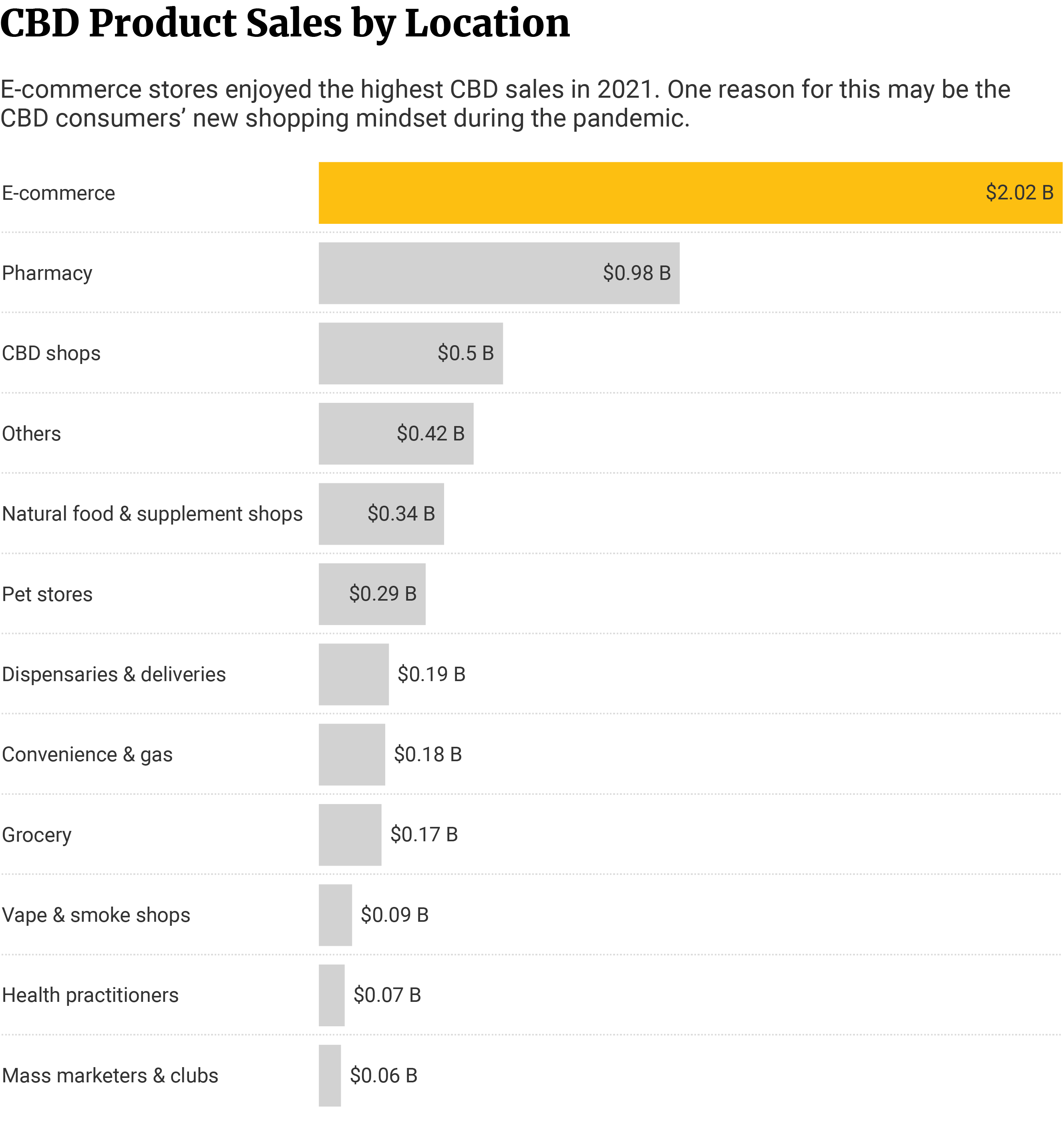
Factors that may have contributed to e-commerce sales growth include the COVID-19 pandemic and CBD consumers’ new shopping mindset. CBD vendors had to adapt to the situation to continue providing service to their customers during the pandemic.
If market trends and predictions stay true, e-commerce CBD sales will increase from $3.01 billion in 2022 to $6.08 billion by 2026. This has steadily increased since 2019’s $1.32 billion [16].
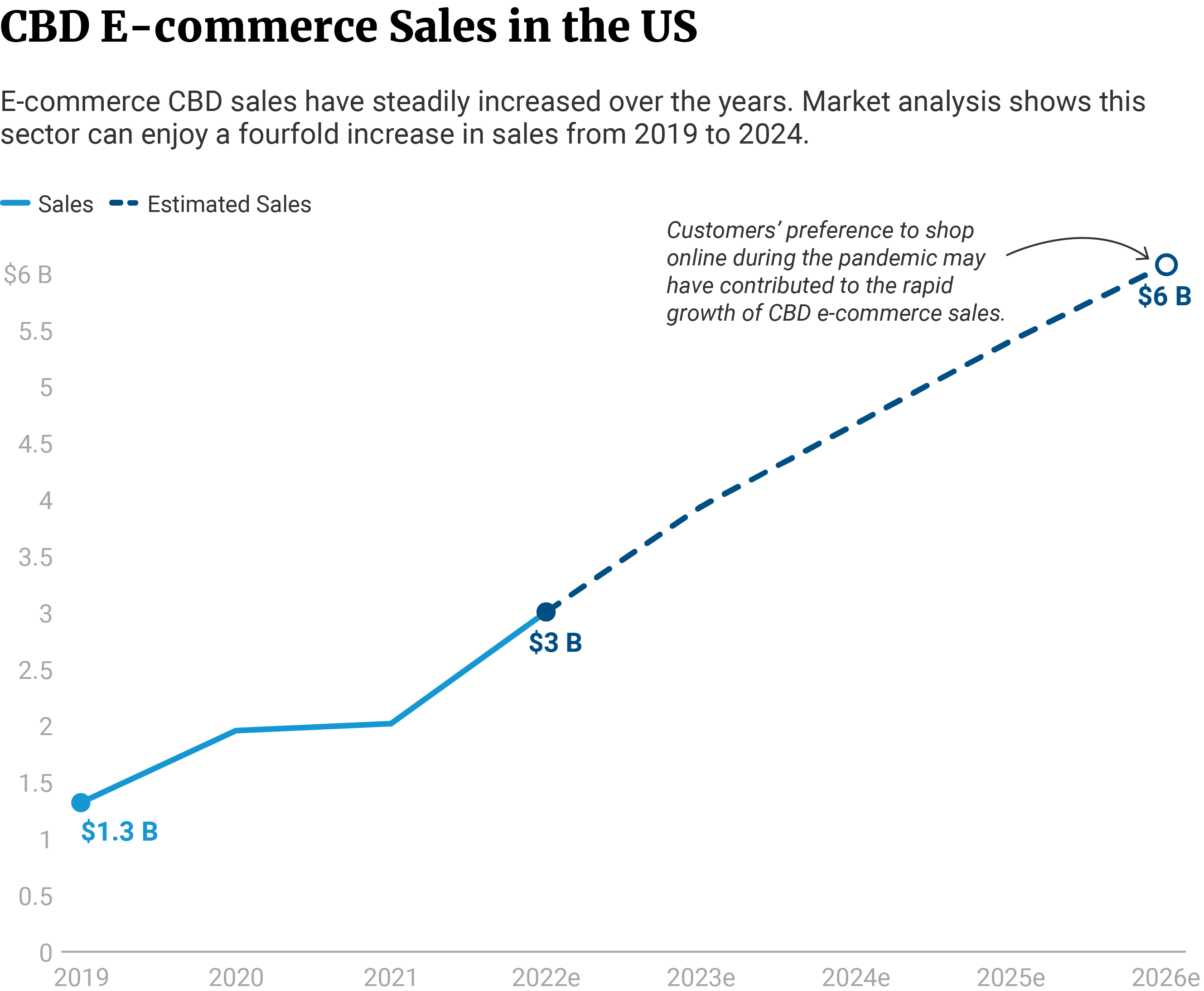
How Big is the Pet CBD Market?
Pet owners spent $561 million on pet CBD products in 2021, an increase from 2017’s $8 million [4].
This is one of CBD’s niche markets that quickly grew through the years. In 2017, the pet CBD market was only a single-digit million-dollar industry. By 2019, it grew into a triple-digit million-dollar industry.
By the end of 2026, the pet CBD industry is expected to become a $1.1-billion-dollar market [36].

CBD has captured the attention of millions. Today, a lesser-known cannabinoid called delta 8 THC is also gaining popularity in the cannabis space.
Will delta 8 THC be the next CBD?
What is Delta 8 THC?
Delta 8 THC is a naturally-occurring cannabinoid in the cannabis plant. As THC degrades, it transforms into other cannabinoids, one of which is delta 8 THC.
However, this process only yields a small amount of delta 8 THC. To produce more, we synthesize it from CBD, a process we’ve known since the early 2000s.
Delta 8 THC isn’t a newly discovered cannabinoid though. Researchers discovered it in the early 1940s. It only became extremely popular after the passage of the 2018 Farm Bill.
The 2018 Farm Bill was signed into law in 2018. It legalized industrial hemp and all its parts, as long as its delta 9 THC content doesn’t exceed 0.3% on a dry weight basis [26]. It also gave us the opportunity to produce more delta 8 from hemp-derived CBD.
Today, delta 8 is one of the fastest-growing products in the cannabis space. It has carved its own niche in the highly-competitive market.
But what do we know of delta 8 THC?
Read on to discover new facts and statistics about delta 8 THC.
How Potent is Delta 8 THC Compared to Delta 9 THC?
A psychoactive compound, delta 8 THC has two-thirds of delta 9 THC’s potency [34]. The compound’s psychoactive effects produce a milder and smoother high than delta 9 THC (also simply called THC). It also produces fewer side effects.
Some factors contribute to these differences [30]:
- Delta 8 THC almost has a similar chemical structure to delta 9 THC. However, you’ll find its double bond between the 8th and the 9th carbon atoms. In delta 9 THC, it’s between the 9th and 10th carbon atoms. The location of its double bond makes it a bit difficult for delta 8 to dock on the cannabinoid receptor type 1. This effect results in a milder and smoother high.
- Delta 8 THC is also a more stable compound than THC. Not only does this produce fewer side effects but also prolongs its shelf life.
These effects quickly made delta 8 THC one of the most popular products in the cannabis industry, especially in non-legal states. Its lower psychotropic potency makes it even more alluring to consumers who want to avoid THC’s side effects.
Related: Marijuana Statistics & Facts
Delta 8 THC Statistics: How Popular is Delta 8 THC?
From 2019 to 2020, the search rate for delta 8 THC increased by 257% globally. This further increased by 705% between the years 2020 and 2021 [35]. Before 2019, search activity for delta 8 THC remained pretty stable but way below 170 QF (query fraction) per 10 million [35].
The rapid increase in the rate of the global search was primarily driven by US’ interest in delta 8 THC.
Between the years 2019 and 2020, the search activity for delta 8 THC in the US increased by 466.8%. The rate almost doubled when it again increased by 850.2% from 2020 to 2021 [35].
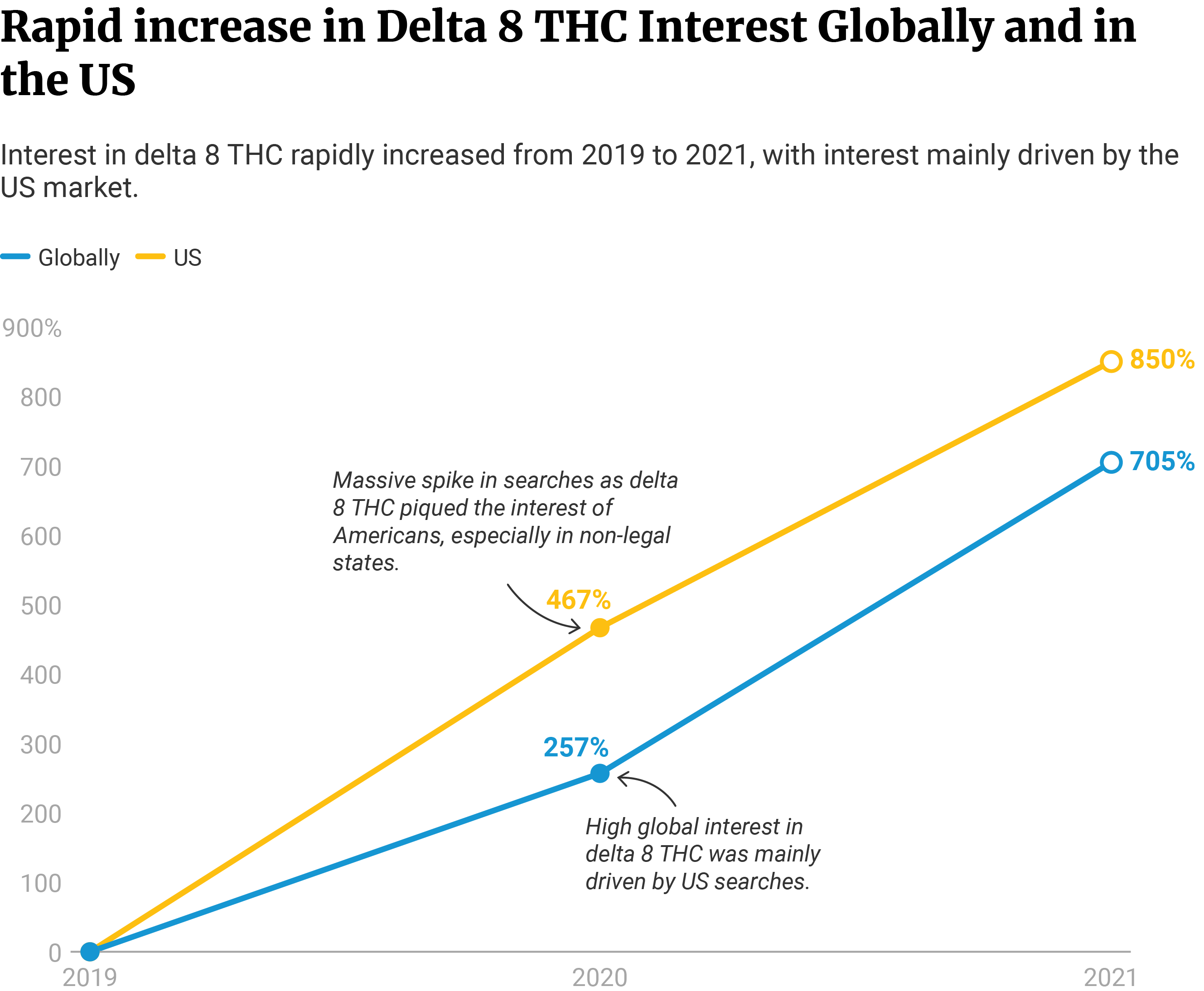
US search activity for delta 8 THC was easily 10 times higher than other countries, its query fraction reaching 828 QF per 10 million. Its closest comparison during the same period was the non-US, British Overseas Territory of Saint Helena, Ascension, and Tristan da Cunha with 78 QF per 10 million [35].
From January to August 2021, delta 8 THC accounted for 22.3 million searches in the US. The increase in search activities occurred across all states, including the District of Columbia. However, search activities were significantly higher in non-legal states [35].
QF in non-legal states was 2.8 times higher than in legal states. QF in states where cannabis is only legal for medical use was 2.3 times higher than in legal states [35].
Google Trends between December 2020 and June 2021 showed that interest in delta 8 was highest in fully illegal and mixed states [28].
- Among the mixed states, interest was highest in West Virginia with 100. Alabama and Kentucky both land in second place with 80 each. Tennessee follows in third place with 74.
- Of the fully illegal states, interest was highest in Nebraska at 65, South Carolina at 58, and North Carolina at 56.

During that same period, Google Trends also showed that delta 8 interest peaked in mid-December 2020 at 100 before dropping to 68 and plateauing [28].
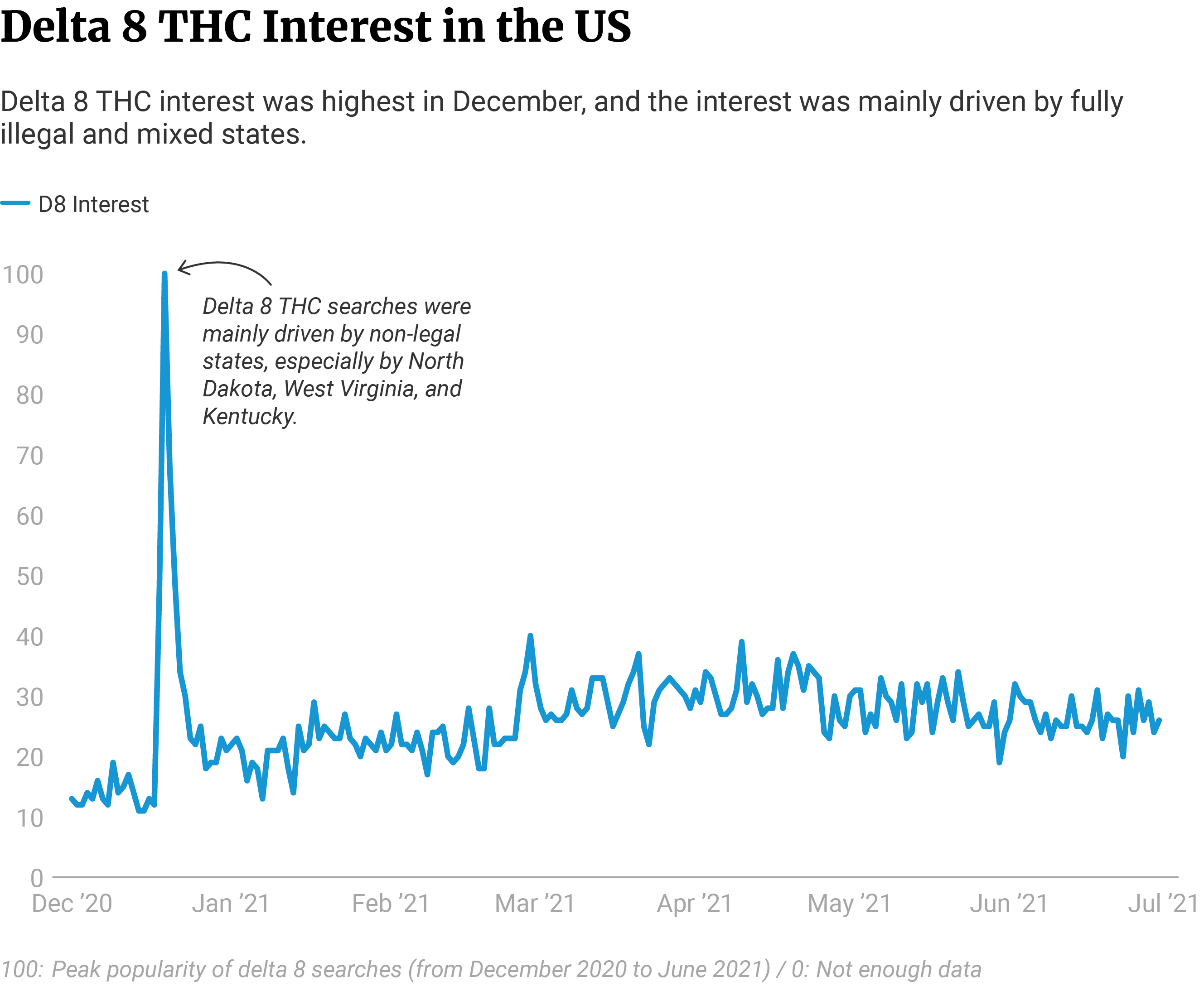
Note: 100 shows the peak popularity of delta 8 THC search during the period in that region.
Brightfield Group also tracked the rapid rise of delta 8 THC’s popularity.
From December 2020 to April 2021, they noted that the buzz surrounding delta 8 THC online grew by 163% [23].
However, delta 8 THC awareness is low and a bit limited to CBD users. We don’t have enough data yet on delta 8 awareness among the general population.
In Q2 of 2021, 23% of American CBD users already knew about delta 8 THC. This percentage is up from Q1 2021’s 19%, an increase of 21% for such a young product [23].
Of the 23% of CBD users, 50% have used delta 8 THC. 20% also bought and used delta 8 THC several times [23].
Delta 8 THC Demographics: How Many People Use Delta 8 THC?
1 in 6 marijuana users reports using delta 8 THC products [37].
16.7% of those who used marijuana in the past 30 days reported using delta 8 [37].
It’s also interesting to note that 20% of delta 8 THC early users don’t use delta 9 THC [23].
80% of those who purchased delta 8 THC use THC-dominant marijuana products [23].
Delta 8 THC Demographics by Age and Gender
Of the delta 8 users, 53% of them are women and 47% are men [23].
However, a survey comparing CBD and delta 8 THC showed the opposite.
6.2% of men who currently use CBD also use delta 8 THC. In women, only 2.4% of current CBD users use delta 8 THC [11].
Men are also 40% more likely to use delta 8 THC than women [37].
The average age of delta 8 THC consumers is 34 [23].
Delta 8 THC Demographics by Location
58% of delta 8 THC users live in rural areas. 42% live in cities [23].
Delta 8 THC gained popularity in non-legal states. It gave people a legal alternative to THC, especially since hemp-derived delta 8 can be sold online and shipped through the mail.
People living in non-legal states or states with restrictive cannabis laws are more likely to use delta 8 THC products. These states include [23]:
- Georgia
- Indiana
- Missouri
- North Carolina
- Pennsylvania
- South Carolina
- Tennessee
- Virginia
- Wisconsin
Related: Delta 8 Near Me
Delta 8 Consumer Experiences: What are the Effects of Delta 8 THC?
A milder version of THC, 74% say delta 8 THC gave them a more alert sense of time, while 71% say it relaxes them [34].
68% say it makes them feel euphoric [34].
Delta 8 THC, similar to THC, also reduces pain. Of those who use delta 8, 55% say it helped relieve their pain [34].
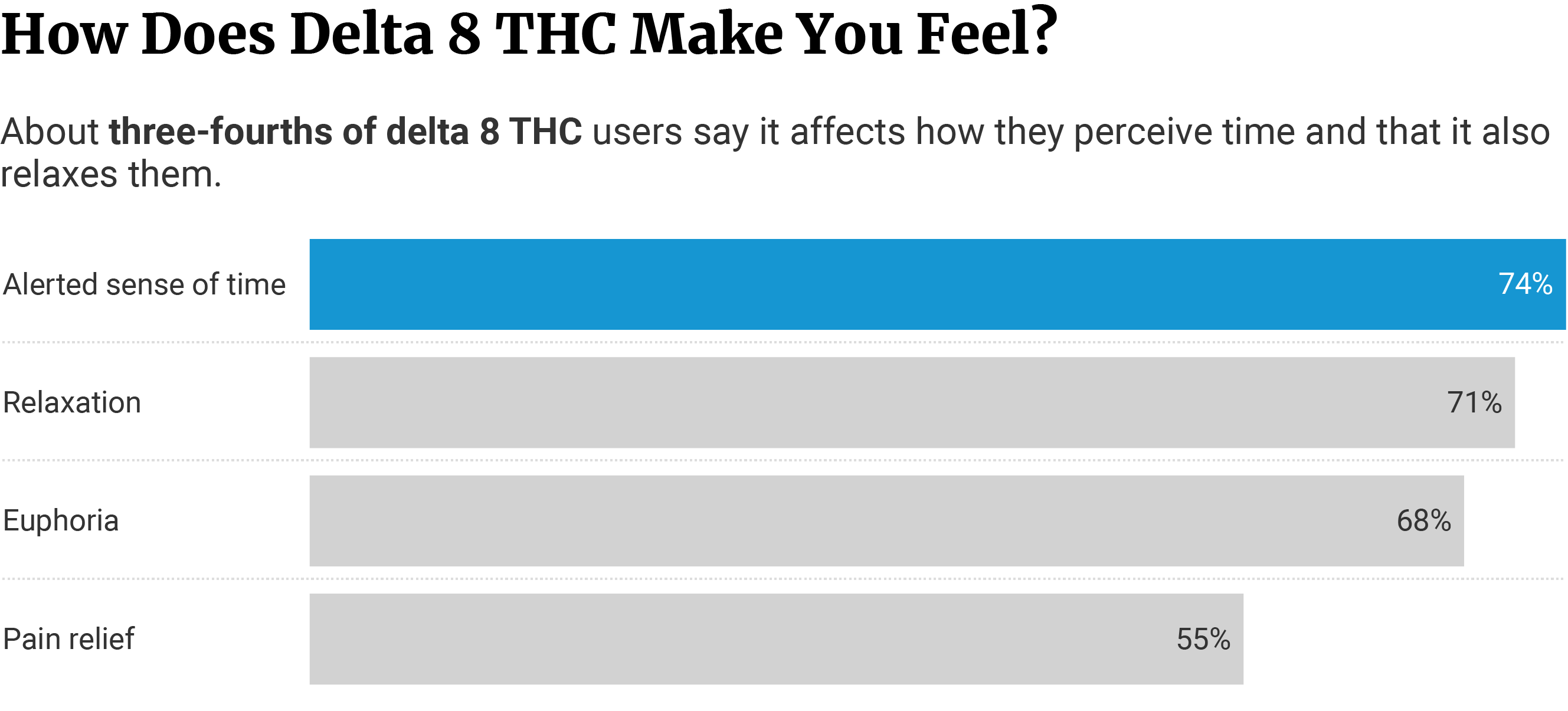
What are the Negative Effects of Delta 8 THC?
81% say using delta 8 THC made it difficult for them to concentrate and focus [34].
80% also say it affected their short-term memory [34].
However, unlike THC, delta 8 didn’t trigger anxiety and paranoia. These are common side effects of consuming high THC.
83% say delta 8 THC didn’t trigger paranoia, and 74% say it didn’t trigger anxiety [34].
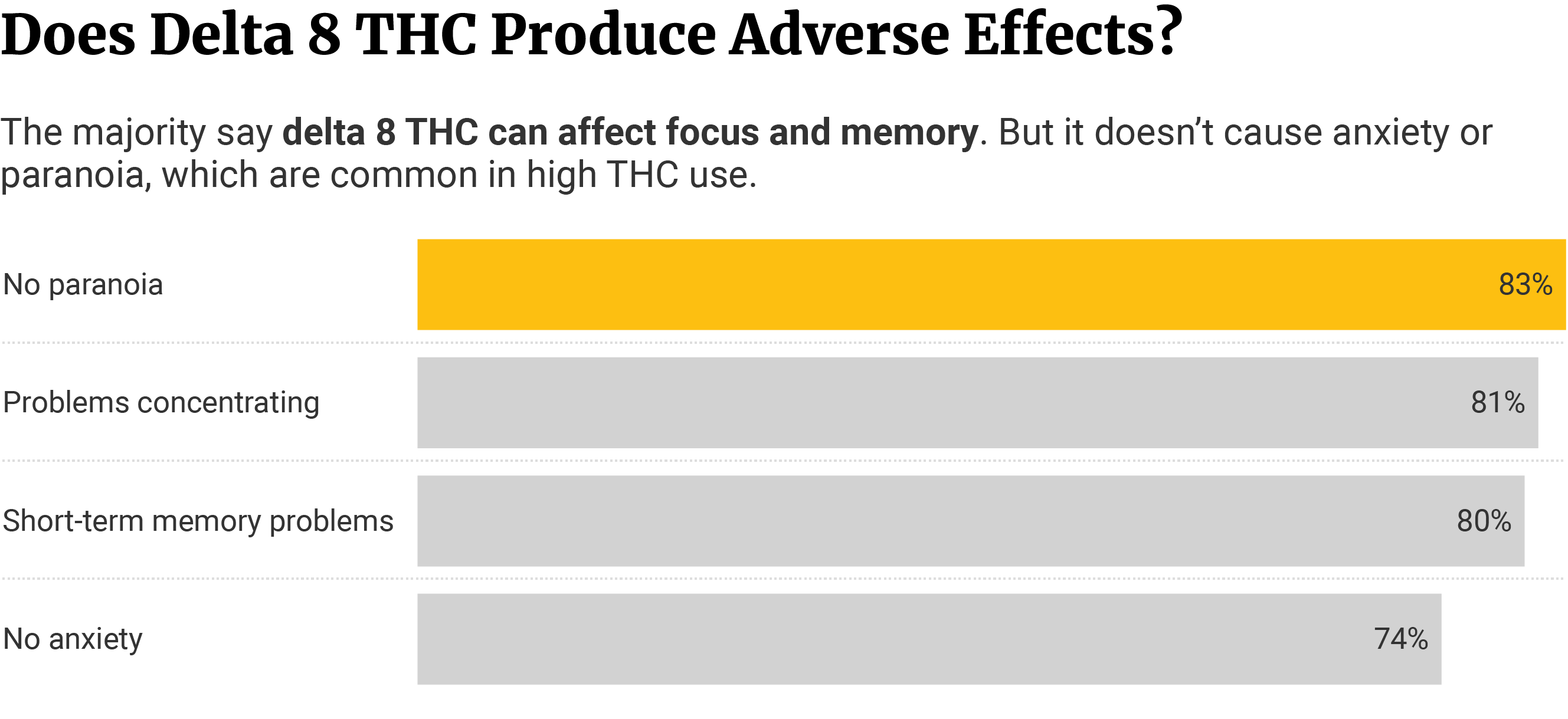
Delta 8 THC vs Delta 9 THC: How Does Delta 8 THC Compare with Delta 9 THC?
80% say THC or delta 9 THC produces more intense effects than delta 8 THC [34].
15% say the effects are about the same [34].
6% say they felt delta 8 THC was more intense than delta 9 THC [34].
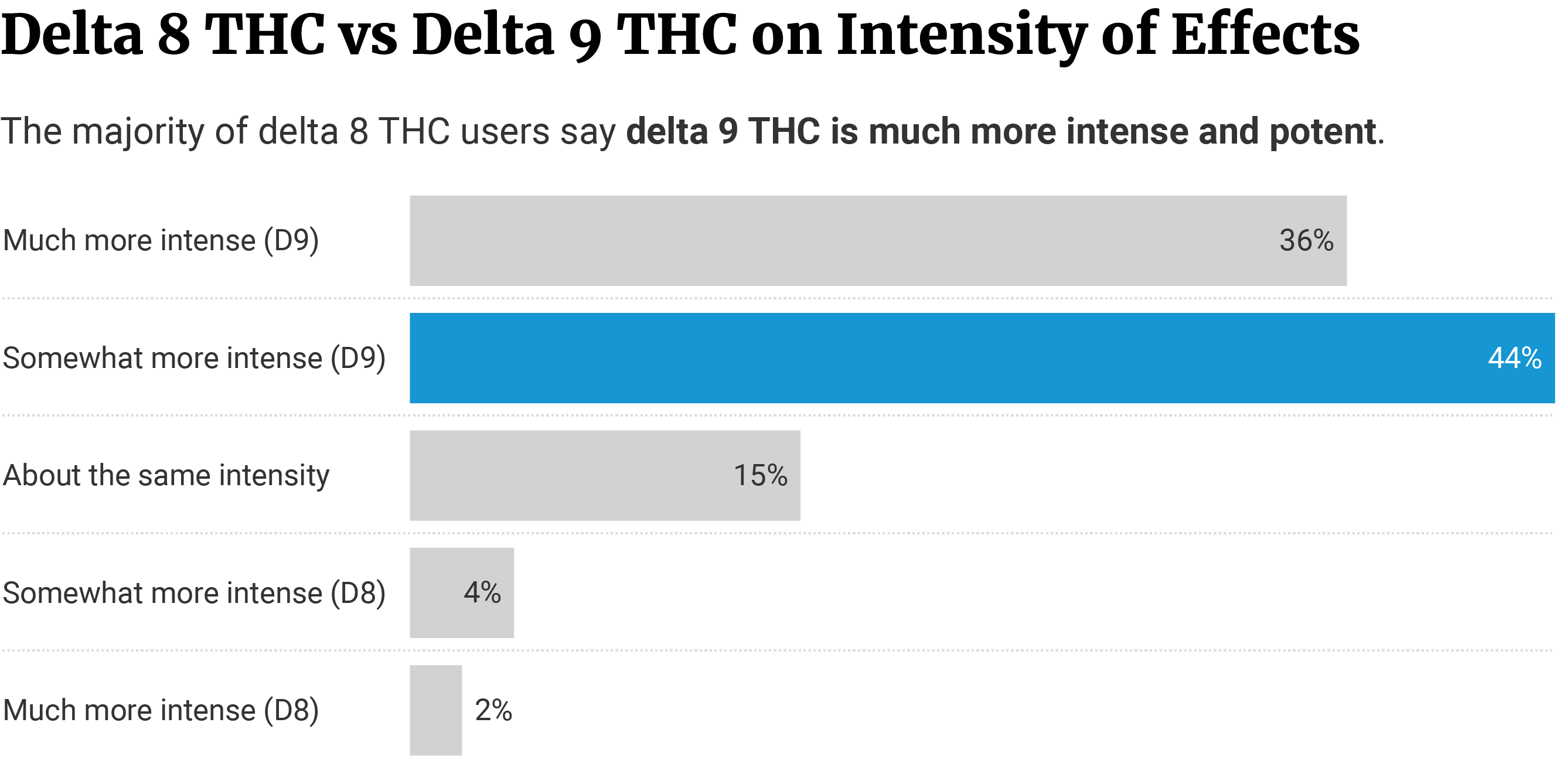
As for the duration of effects, 47% say THC or delta 9 THC lasts longer than delta 8 THC [34].
41% say their duration of effects is about the same [34].
13% say delta 8 THC lasts longer than delta 9 THC [34].
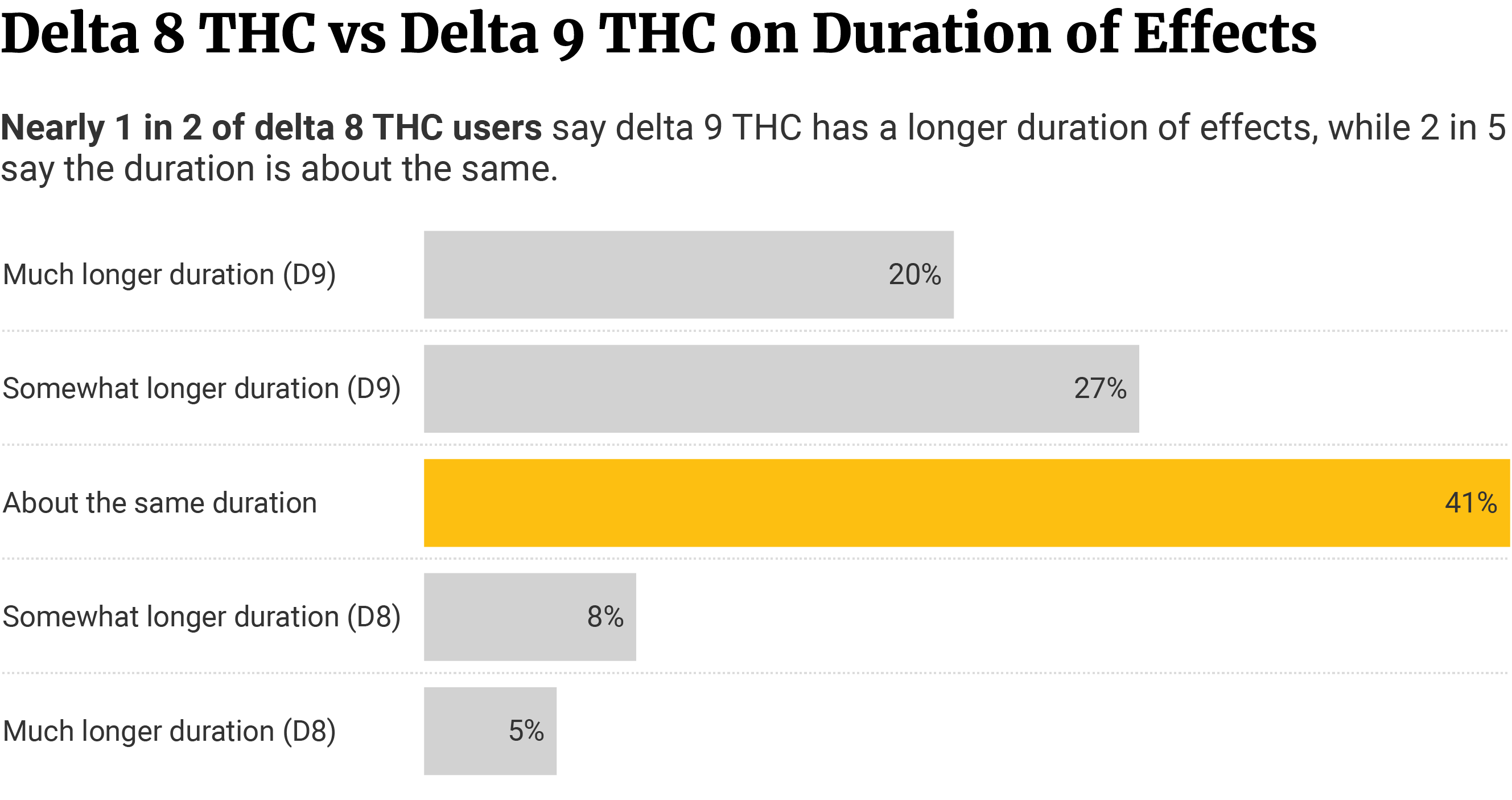
57% of delta 8 users say they’ve switched from THC to delta 8 [34].
59% also say they switched to delta 8 THC from pharmaceutical drugs [34].
Delta 8 THC vs CBD: How Does Delta 8 THC Compare with CBD?
20% of social conversations around delta 8 THC associate it with relaxation. As for CBD, only 9% of online conversations talk about CBD and relaxation [23].
However, more people also associate CBD with exercise, skincare, and beauty.
14% of online conversations associate skincare and beauty with CBD, compared to only 4% to delta 8 THC [23].
11% of online social discussions talk of CBD and exercise. This is only 5% for delta 8 THC [23].
19% of social conversations say CBD is more sustainable. With delta 8, only 17% say it’s sustainable [23].

Why Do People Use Delta 8 THC?
51% of delta 8 THC users use it for medical purposes, especially for their mental health [33].
Of this percentage, 69% use delta 8 for controlling anxiety and panic attacks. 52% use it to reduce their stress [33].
46% use delta 8 for depression and bipolar disorder [33].
41% use it for pain control [33].
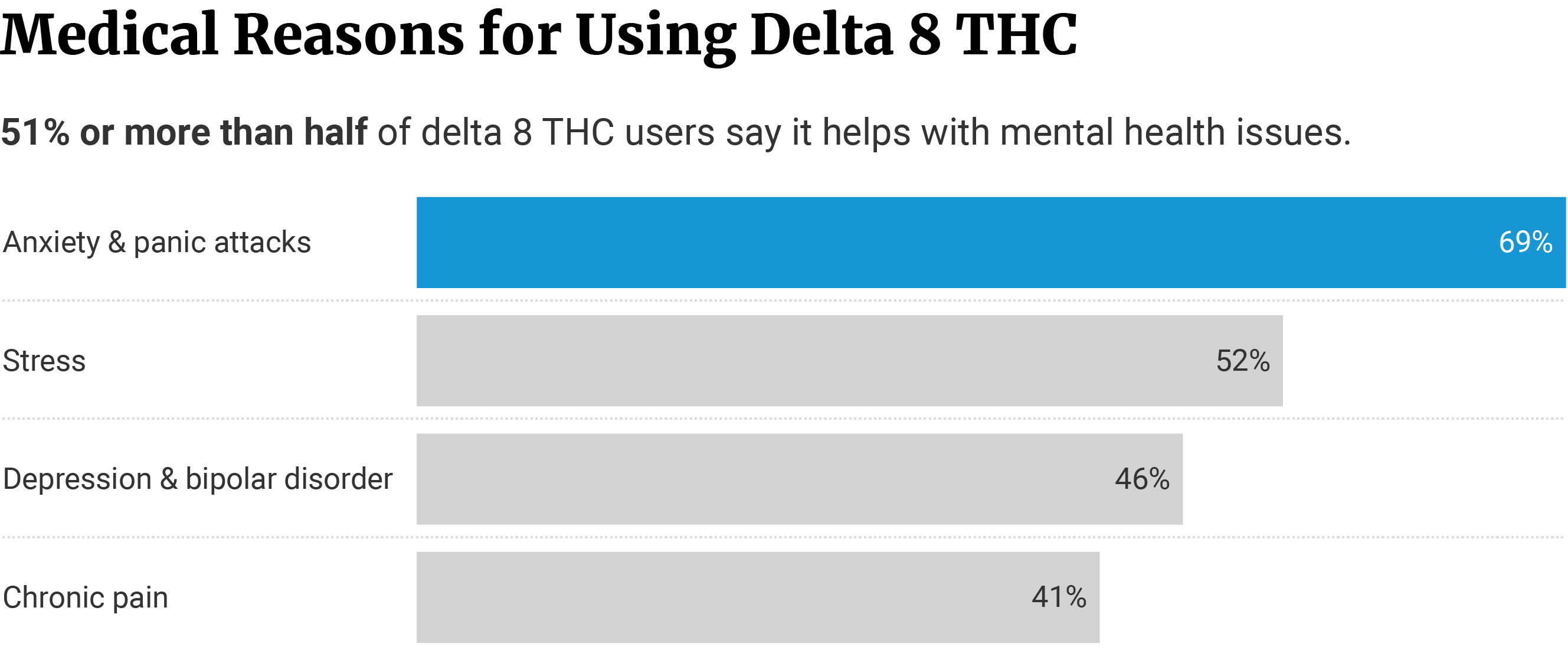
Another survey also showed that the majority of its respondents use delta 8 for medical purposes. The data came from an online survey of 4,348 adult marijuana users.
8.10% out of the 4,348 respondents use delta 8 THC for its therapeutic value [37].
- 5.01% use delta 8 THC for depression.
- 1.82% consume delta 8 THC for insomnia.
- 1.26% find delta 8 THC helpful for pain.
Its legality and curiosity about it are also top reasons why people use delta 8 THC.
4.35% use delta 8 THC because it’s federally legal, compared to delta 9 THC which remains illegal on a federal level [37].
3.10% also use it because it’s new and worth trying [37].
1.13% consume delta 8 THC for recreational purposes. They want to get a little high or be more relaxed and mellow [37].
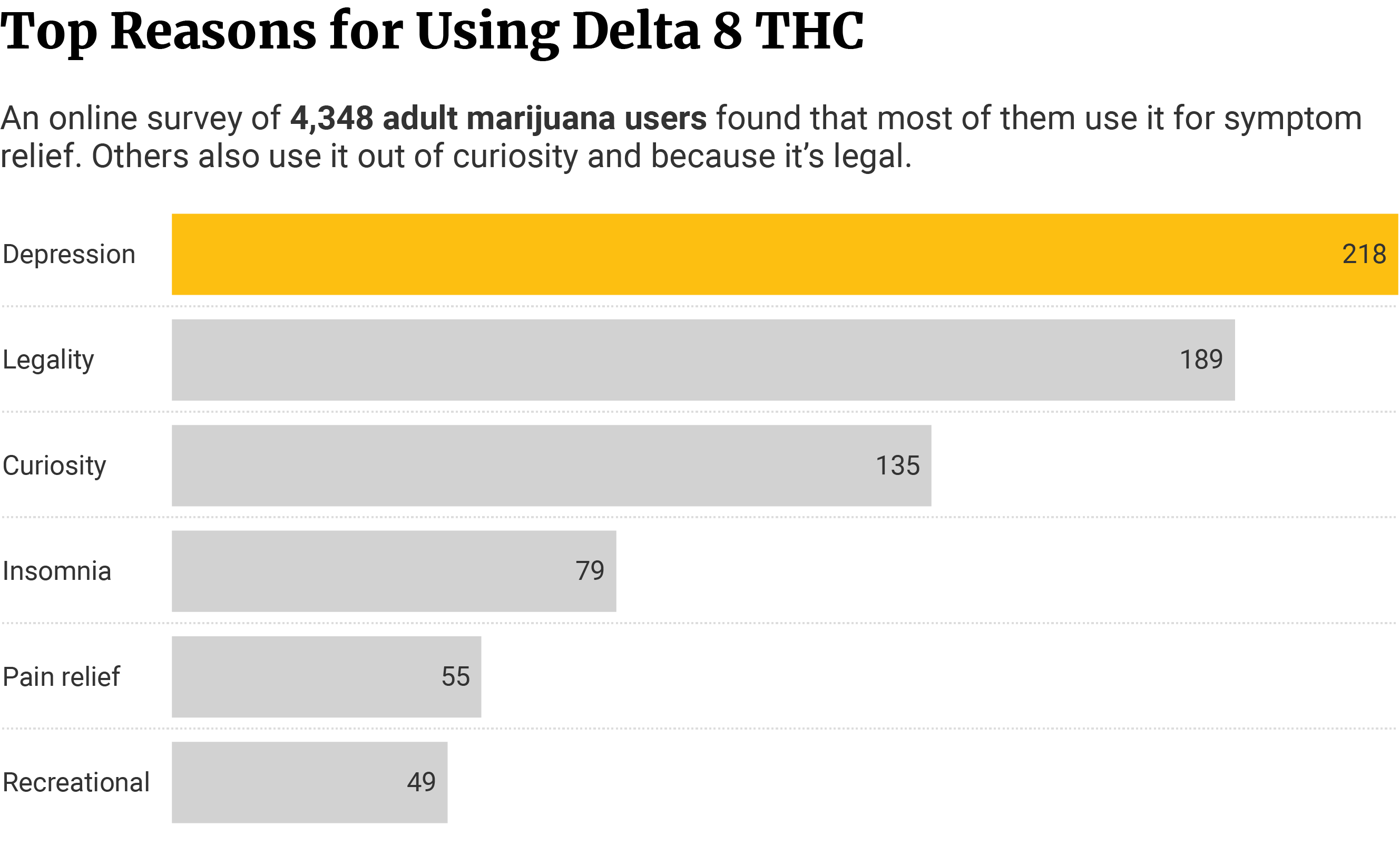
Delta 8 Consumption Methods: What are the Most Popular Delta 8 THC Products?
64% say they take delta 8 THC edibles. These include brownies, candies, gummies, or chocolates infused with delta 8 THC [34].
32% use delta 8 THC tinctures, and 9% use delta 8 THC topicals [34].
On vaping and smoking, 57% prefer vaping delta 8 THC, and 41% prefer smoking delta 8 THC [34].
48% vape delta 8 concentrates. 9% vape delta 8 THC-infused bud or flower [34].
23% smoke delta 8 concentrates. 18% smoke delta 8 THC-infused bud or flower [34].
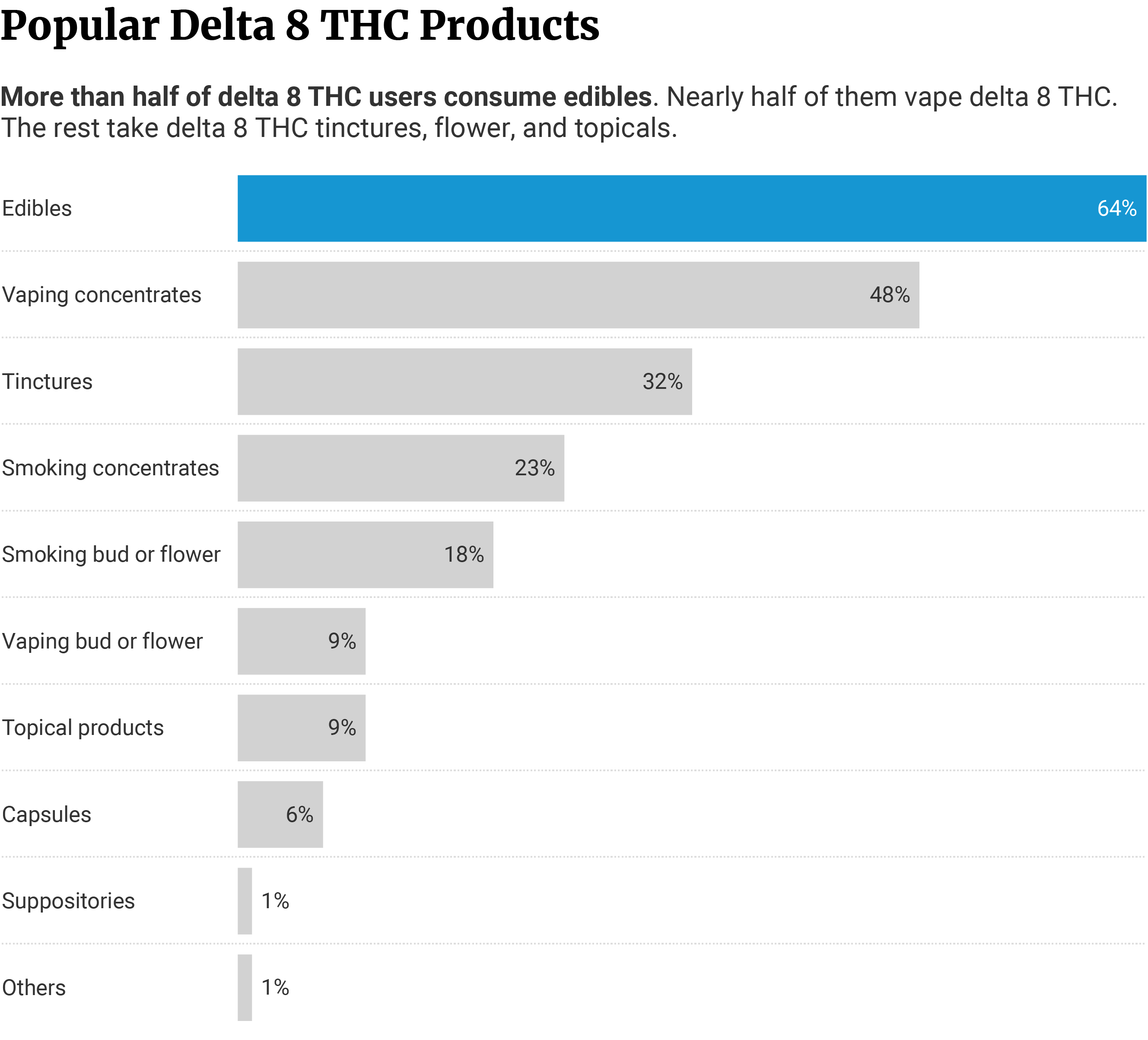
Another survey found almost similar results. It also showed that edibles are the preferred method of consumption. The data below came from an online delta 8 THC survey composed of 4,348 adult marijuana users.
10.19% consume delta 8 THC edibles [37].
- 5.15% use any form of delta 8 THC edibles.
- 4.16% choose delta 8 THC gummy candies.
- 0.87% consume other forms of delta 8 THC edibles. These include baked goods, chocolates, and hard candies.
6.88% use delta 8 THC vapes, while 2.37% smoke delta 8 THC [37].

What is the Current Delta 8 THC Market?
The demand for delta 8 THC soared and retail sales reached $10 million in 2020 alone [53].
By April 2021, retail sales grew by 144% [41].
With sales reaching about $24.4 million, delta 8 THC is one niche that’s making waves in the cannabis landscape.
How Do I Get Delta 8 THC Products?
8.65% of delta 8 THC users get their products from non-dispensary stores [37]. These include smoke, vaping, and tobacco shops. They also include headshops, convenience stores, and even gas stations.
2.85% buy their delta 8 THC products from marijuana dispensaries [37].
2.32% get theirs from friends. They either bought the product, or their friends gave it to them [37].
1.79% buy their delta 8 THC online [37].
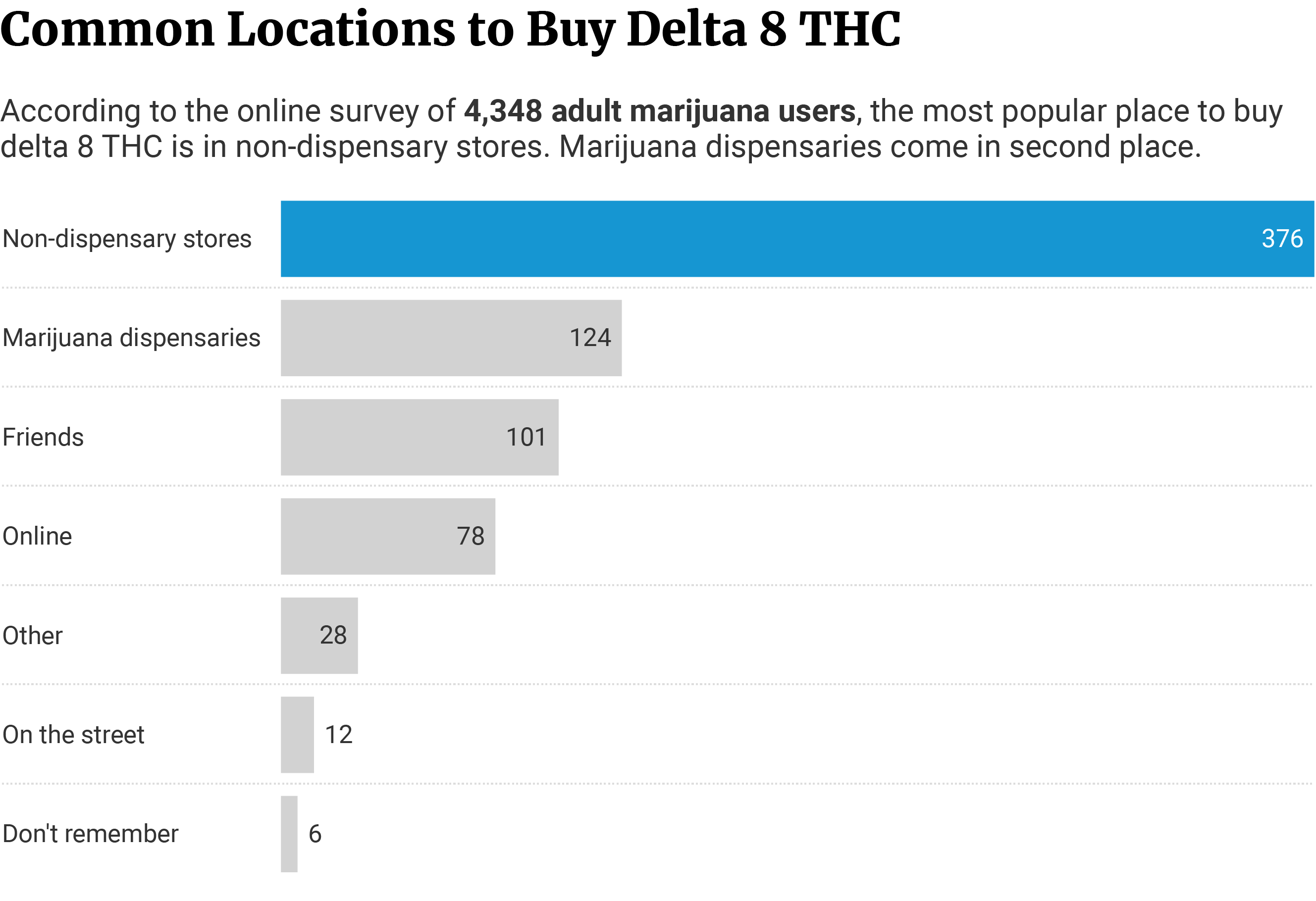
Again, the data came from an online survey of 4,348 adults using marijuana.
Delta 8 THC Safety Concerns: Is Delta 8 THC Safe?
Out of the 104 delta 8 adverse event cases reported to the FDA, 66% of them involved ingesting edibles. 55% required medical intervention [1]. The data came from December 2020 to February 2022 adverse event report.
Some of the adverse side effects include:
- Anxiety
- Hallucinations
- Tremors
- Loss of consciousness
- Dizziness
- Vomiting
- Confusion
Of the cases, 77% of them are adults and 8% are minors [1].
2,362 delta 8 unintentional exposure cases had also been received by the national poison control centers between January 2001 to February 2022 [1].
40% involved unintentional delta 8 THC exposure, 82% of which involved minors [1].
70% of the cases required medical evaluation and intervention, 45% of which involved minors. Of the 70%, 8% needed critical care unit services [1].
One pediatric patient died from unintentional delta 8 THC exposure [1].
Of the cases, 58% involved adults, and 41% involved minors [1].
Delta 8 THC is a relatively new cannabis product, a niche that’s still highly unregulated. It’s for this reason that one has to be careful in choosing the delta 8 THC producer.
- Choose hemp-derived delta 8 products
- Know the ingredients and make sure they’re organic
- Always make sure that the product is laboratory-tested and has a certificate of analysis
- Always buy from trusted sources
- Always read reviews and customer feedback before trying new products
Is Delta 8 THC Legal?
Although the 2018 Farm Bill technically made delta 8 THC legal, 17 states and the District of Columbia have banned the production, sale, and use of this cannabinoid [46].
- Alaska
- Arizona
- Arkansas
- California
- Colorado
- District of Columbia
- Delaware
- Idaho
- Iowa
- Mississippi
- Montana
- Nevada
- New York
- North Dakota
- Rhode Island
- Utah
- Vermont
- Washington
Five states have regulated delta 8 THC the same as marijuana:
- Connecticut [51]
- Louisiana [3]
- Maryland [9]
- Michigan [22]
- South Dakota [2]
As for the other states and territories, delta 8 THC is either legal or falls under a legal gray area.
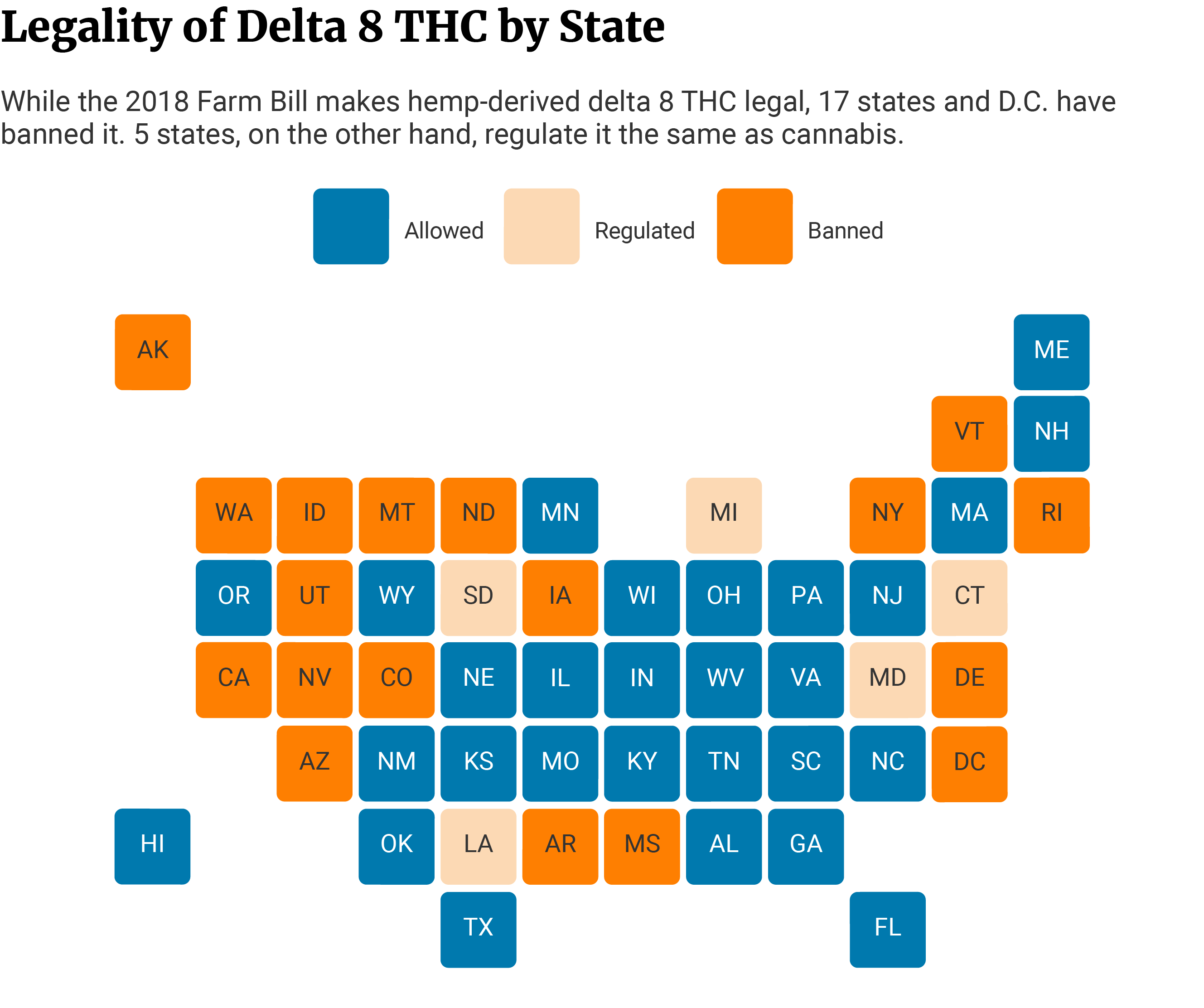
Should Delta 8 THC Be Regulated?
Out of 295 respondents that work in the marijuana and hemp industry, 59% say the delta 8 THC space needs no additional regulations [6].
35% say delta 8 THC should be regulated like marijuana [6].
32% say purity and quality regulations should be put in place [6].
26% of the respondents say testing standards for delta 8 THC should be implemented [6].
23% also say that there should be an age limit for delta 8 THC use [6].
18% say labeling requirements should be set, while 6% say there should be dosage limits [6].
13% say delta 8 THC should be banned and taken off the market [6].
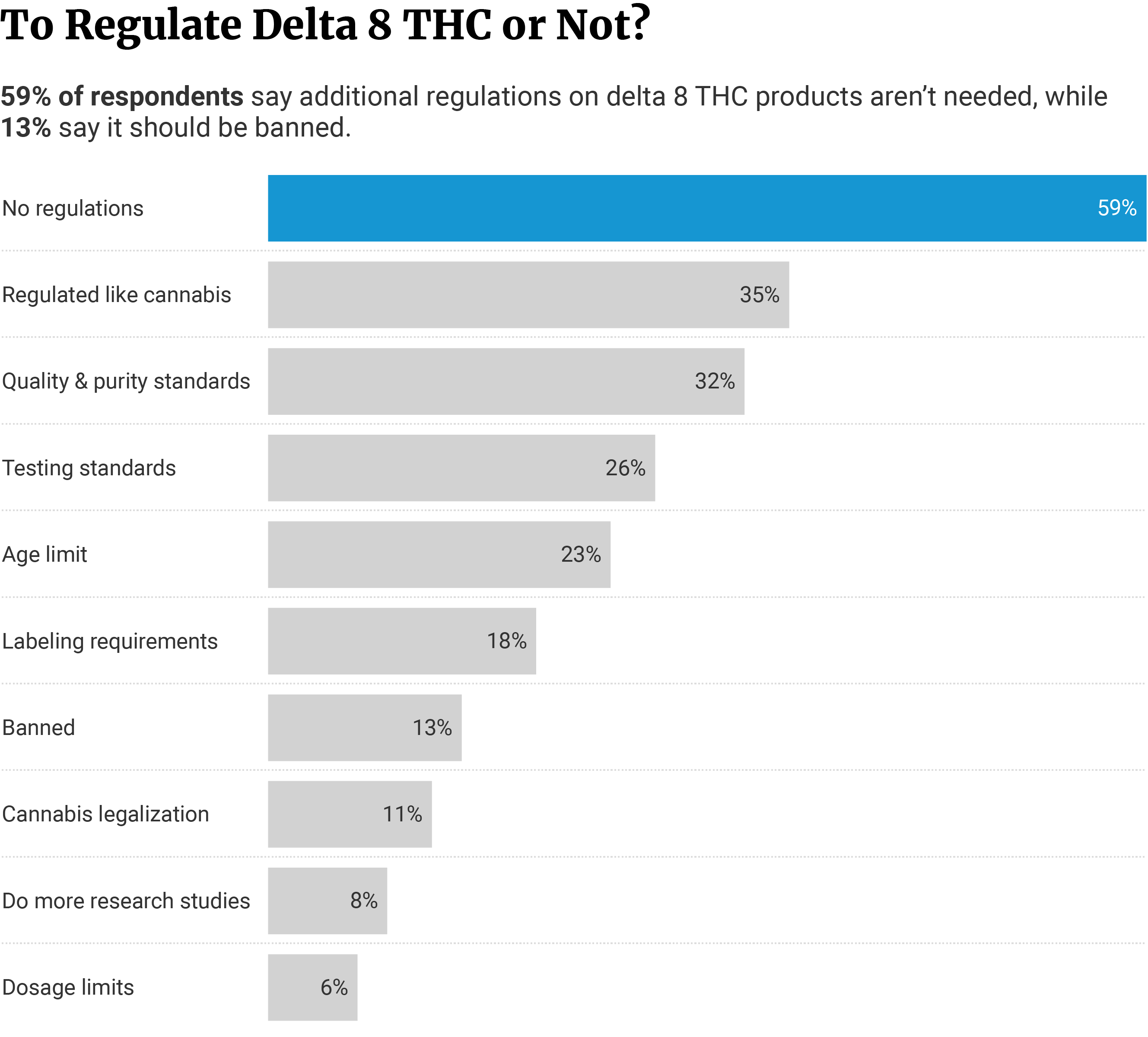
51% of the respondents say delta 8 THC belongs in the hemp market where it should be produced and sold. 35% disagree [6].

59% of the respondents say delta 8 THC belongs in the cannabis space where it should be produced and sold. 23% say it doesn’t [6].

Are All Hemp and Cannabis Products Tested for Safety?
75% or 3 in 4 brands test some of their CBD products for purity. These include looking for impurities and contaminants like heavy metals, pesticides, and pathogenic microorganisms [29].
13% send for purity testing almost all of their products [29].
25% or 1 in 4 don’t test for impurities at all [29].
Of those who test for purity, only 35% of them published the laboratory results of 10% or less of their products [29].

Are All Hemp and Cannabis Products Tested for Potency?
Only 42% of the brands run 90% to 100% of their products through third-party potency testing [29]. They also share the laboratory results with their consumers.
Of those who test for potency, only 4% of them publish the laboratory result of 10% or less of their products [29].
84% of the products tested for potency failed to meet the acceptable potency variance level of within 10% [29]. This means that the potency of the product is either 10% lower or 10% higher than what’s stated on its product label.
Only 16% of the products contained what’s stated on their product labels [29].

A recent report also found almost similar results.
Out of 221 products, only 88 or 40% of them were actually within the acceptable potency variance level of 10% [10]. This means that the compounds are within 10% of what’s stated on the product label.
133 or 60% failed to match their labels. 22% contained 20% higher or lower than what’s listed on their product label. 10% and 28% contained 30% and 40%, respectively [10].

Mislabeling of products is also rampant in the delta 8 THC industry.
For delta 8 THC to be legal, it should come from industrial hemp with less than 0.3% THC [43].
However, 76% of 51 delta 8 THC products actually have higher than 0.3% THC. The high THC content technically makes their products illegal under federal laws [43].
77% of the products even contained less than the stated delta 8 THC potency on the label [43].

The US Cannabis Council also tested 16 delta 8 THC products. They found that these contained 1.3% to 5.3% THC levels [34].
Despite these issues though, CBD, delta 8 THC, and other cannabis products continue to grow in popularity. They’ve even invaded the holiday seasons.
Are Cannabis Products Also Taking Over the Holiday Season?
It seems they are. 53.4% out of 630 respondents say they’re using cannabis to relieve holiday stress [24].
45.6% say they even use weed to celebrate the holiday season [24].
Of course, pain remains one of the top reasons why people consume cannabis. 50.3% say they use weed for pain relief [24].
43.3% even say weed helps enhance their creativity [24].
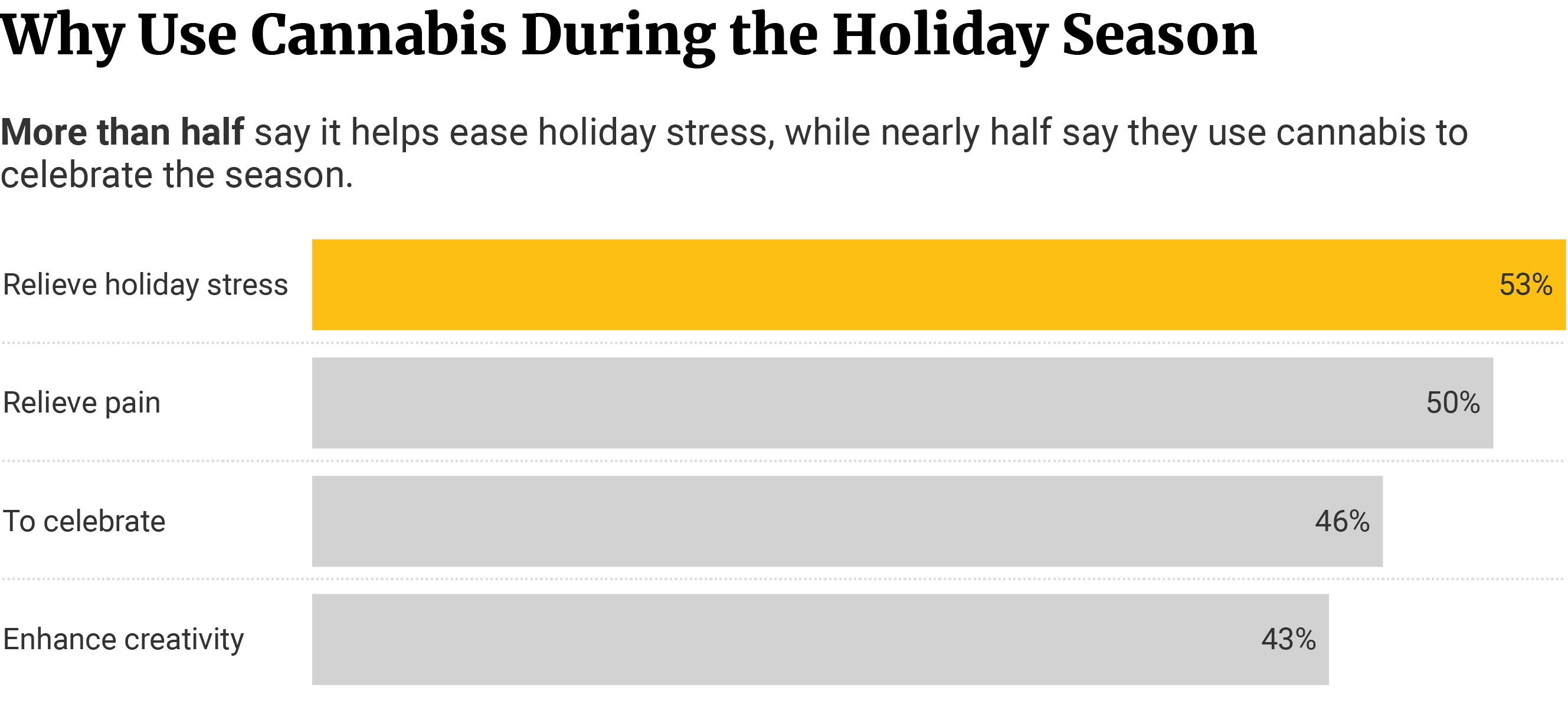
Interestingly, 71.2%, or nearly three-fourths of respondents, say they’re planning on consuming cannabis instead of alcohol during the holiday season [24].
Weed as gifts is also becoming popular during the Yuletide season.
71.2% say they’re thinking of giving cannabis-based products as gifts to friends. 62.5% say they’re giving the same to family members, while 40.8% to their partners or significant others [24].
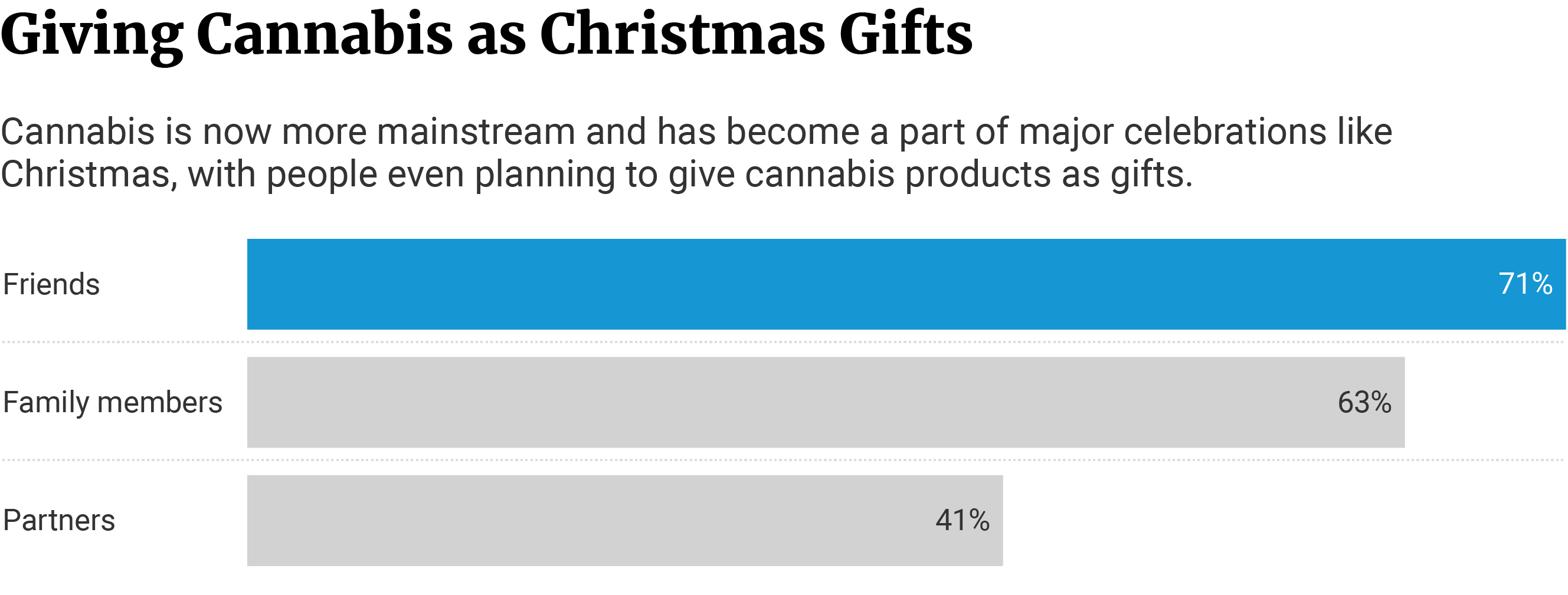
Of the different cannabis products, 65.8% say they’re going to give cannabis flowers [24].
The next best cannabis gifts to give are cannabis edibles and pre-rolls. 61.3% say they plan on gifting someone with cannabis edibles. 54.7% say they plan to give pre-rolls [24].
32.4% of the respondents say CBD products also make great gift choices [24].
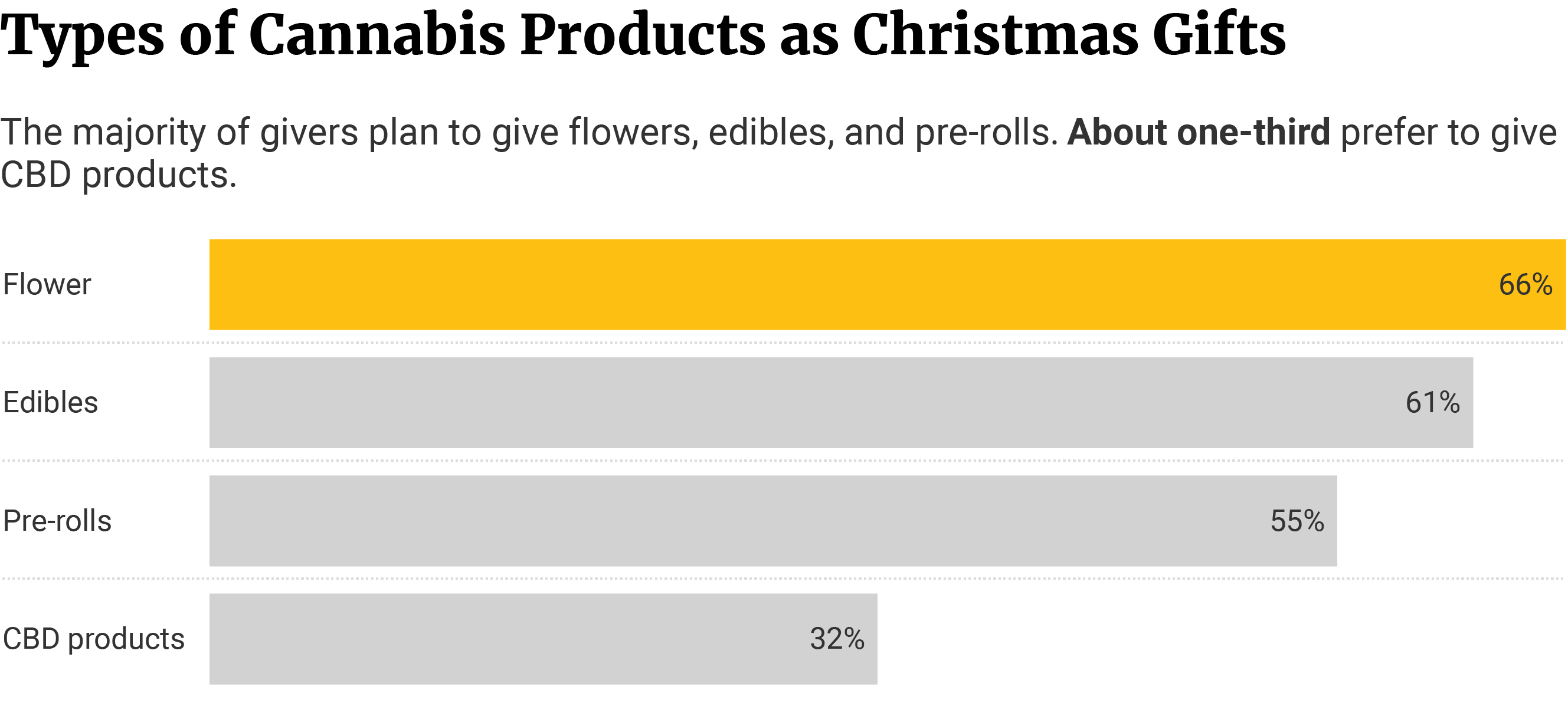
When asked what they’d like to receive this holiday, 69.3% say they want cannabis flowers [24].
Edibles and pre-rolls again come in second and third places. 56.4% say they want to receive cannabis edibles. 51.3% are crossing their fingers for some pre-rolls [24].
33.2% or 1 in 3 respondents would like to receive vape products, while 25.4% or 1 in 5 say they’d love to get some CBD products [24].
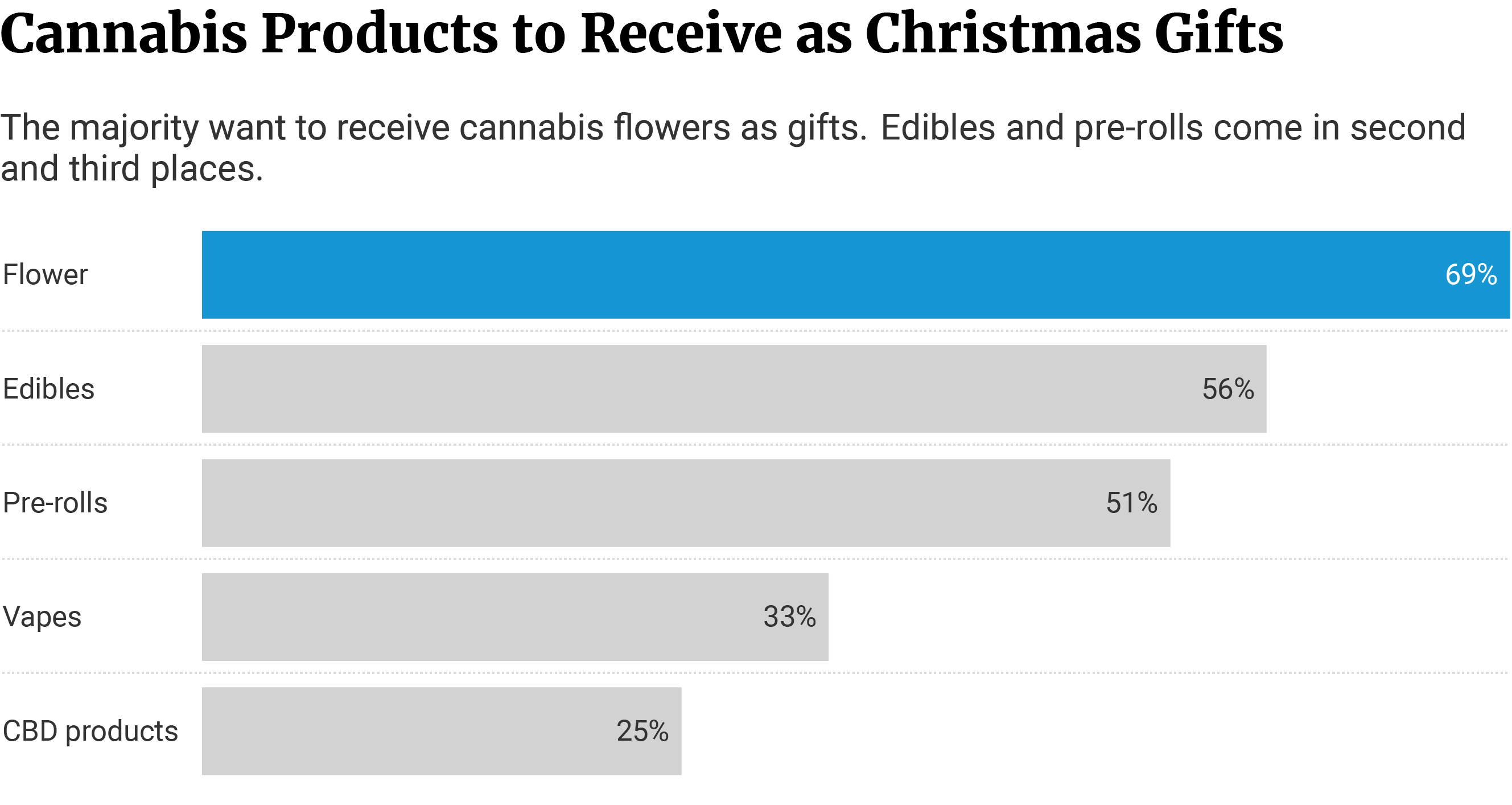
CBD and Delta 8 THC Statistics — Are They Here to Stay or Are They Just a Fad?
The percentage of American CBD consumers has increased from 6% in 2018 to 26% in 2022. Today, over a quarter of the American population has used CBD, with 1 in 7 of them using CBD on a daily basis.
This increase in CBD users has led to an increase in CBD sales. From $4.15 billion in 2019, it’s projected to increase to $7.86 billion by the end of 2022. If this trend continues, we could see the CBD market generating sales of $15.97 billion by 2026.
Pet CBD sales are also up, from $8 million in 2017 to $560 in 2021. CBD trends also show that pet CBD sales could increase to $1.1 billion by 2026.
Is CBD a trend? Or is CBD on the rise?
CBD statistics show that CBD isn’t just a fad and that the CBD industry growth will only continue to grow in the coming years.
Delta 8 THC is a different matter altogether, particularly since it’s still an unregulated space in the cannabis landscape.
For such a young product, its retail sales have already reached at least $10 million, and this is in 2020 alone. However, controversies also surround this cannabinoid.
While the 2018 Farm Bill technically made hemp-derived delta 8 THC legal, some states moved to ban all types of delta 8 THC products. The reasons for delta 8 THC prohibition include:
- The Drug Enforcement Agency’s (DEA) classification of delta 8 THC as a Schedule I controlled substance. The same agency also considers delta 8 THC synthesized from CBD a synthetic cannabinoid since [25].
- Lack of research and testing, especially about its safety
- Mislabeling of delta 8 THC products
Proponents of delta 8 THC also argue that it’s not a synthetic cannabinoid. It’s not like K2 or spice, which is a synthetic form of marijuana. Instead, delta 8 THC is a naturally occurring compound found in nature.
This argument received support from the Ninth Circuit Court of Appeals. The three-judge panel ruled that delta 8 THC synthesized from industrial hemp-derived CBD falls within the 2018 Farm Bill’s scope [42].
Is Delta 8 THC the “New CBD”?
There may have been a spike in delta 8 interest in recent months. However, Google Trends from December 1, 2020, to October 1, 2022, shows that interest in CBD remains much higher.
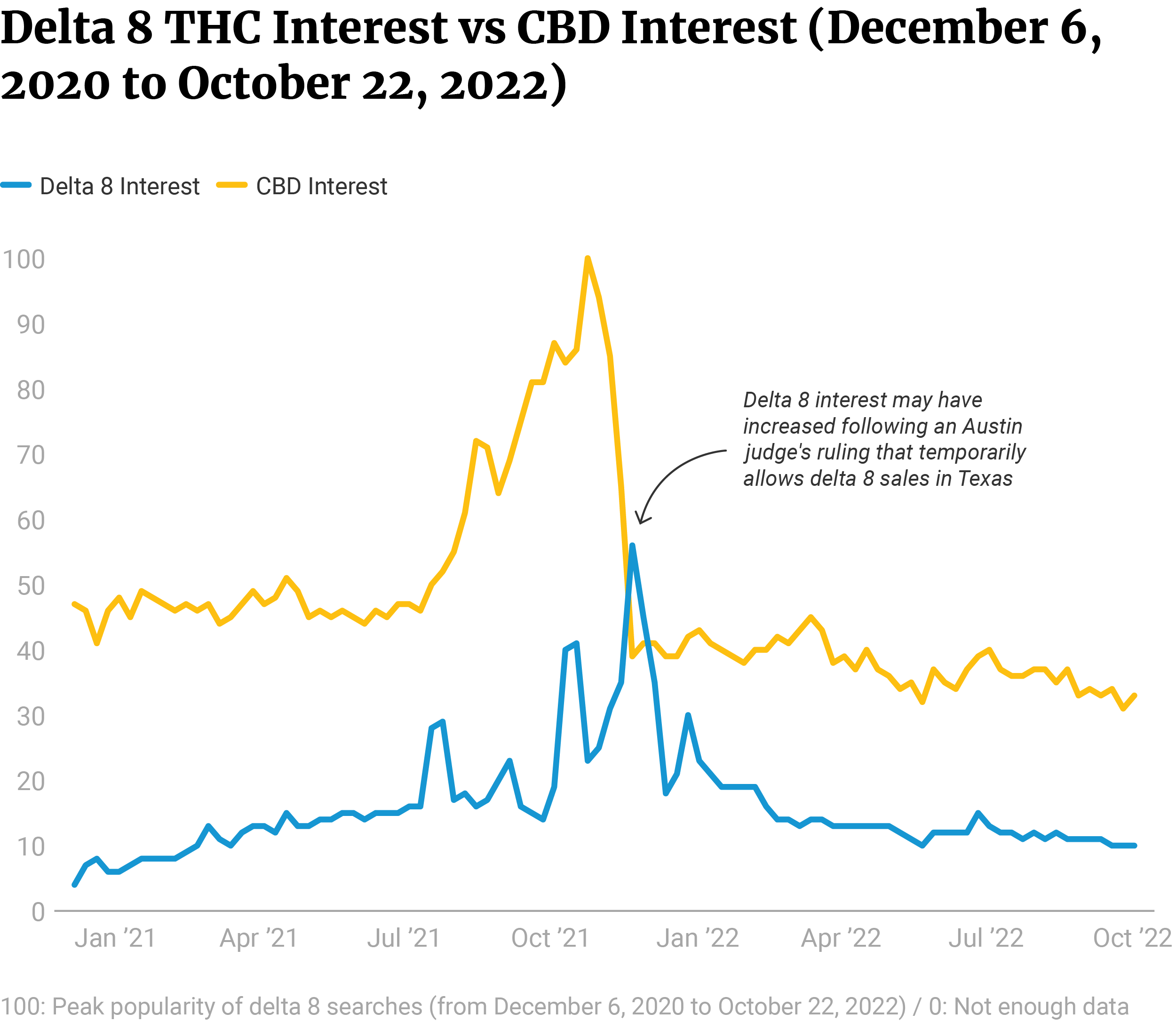
But with the interest delta 8 has gained, some see a promising future for its market. Of course, there are also those who believe that interest in delta 8 will further decline, especially when more states move to legalize delta 9 THC.
Whatever the future holds for delta 8, one thing is for certain — its sales will definitely contribute to CBD’s burgeoning billion-dollar industry.
With the interest it has gained recently, some see a very promising future for the delta 8 THC industry. However, some also believe that interest in delta 8 THC will decline, especially when more states move to legalize delta 9 THC.
Whatever the future of the delta 8 THC industry is, one thing is for certain — its sales will definitely contribute to CBD’s burgeoning billion-dollar industry.
References
- 5 Things to Know about Delta-8 Tetrahydrocannabinol – Delta-8 THC. (2022). US Food & Drug Administration. [1]
- 2022 South Dakota Legislature House Bill 1292. (2022). South Dakota Legislature. [2]
- ATC Advisory: CBD & Consumable Hemp Legislative Update. (2021). The Louisiana Office of Alcohol and Tobacco Control. [3]
- Bedford, E. (2022a). CBD pet products: dollar sales U.S. 2021. Statista. [4]
- Bedford, E. (2022b). Top CBD products for pets U.S. 2021. Statista. [5]
- Bennett, T. (2021). Should Delta-8 THC Be Regulated as Hemp or Cannabis? Survey Shows Clear Divide. Cannabis Business Times. [6]
- Blake, D. K. (2022). CBD For Pets. AmericanMarijuana.org. [7]
- Brenan, M. (2019). 14% of Americans Say They Use CBD Products. Gallup, Inc. [8]
- Cannabis – Regulation – Delta-8- and Delta-10-Tetrahydrocannabinol. (2021). Maryland General Assembly. [9]
- CBD and cannabis third party testing labs: Here’s what you need to know. (2022). Radicle Science. [10]
- Consumer Popularity of Delta-8 THC. (2021). [Data Visualization]. New Frontier Data. [11]
- Conway, J. (2019a). Annual CBD usage rate in the United States from 2018 to 2024. Statista. [12]
- Conway, J. (2019b). CBD/hemp oil usage, by generation U.S. 2019. Statista. [13]
- Conway, J. (2020a). Sales of CBD, by state U.S. 2019. Statista. [14]
- Conway, J. (2020b). Sales of CBD, by state U.S. 2024. Statista. [15]
- Conway, J. (2021). CBD e-commerce sales U.S. 2019-2026. Statista. [16]
- Conway, J. (2022a). CBD hesitancy reasons among U.S. adults 2021. Statista. [17]
- Conway, J. (2022b). CBD product dollar sales U.S. 2019-2026. Statista. [18]
- Conway, J. (2022c). Hemp-based CBD sales by channel U.S. 2021. Statista. [19]
- Conway, J. (2022d). Sales of CBD branded products in the United States in 2021, by product type. Statista. [20]
- Corroon, J., & Phillips, J. A. (2018). A Cross-Sectional Study of Cannabidiol Users. Cannabis and Cannabinoid Research, 3(1), 152–161. [21]
- Delta-8 Information. (2022). State of Michigan. [22]
- Delta-8: The Good, The Bad, and the Insights (+ How Consumers are Reacting). (2022). Brightfield Group. [23]
- Dorbian, I. (2020). Yuletide High: Cannabis Tops Christmas Gifts, Reports Survey. Forbes. [24]
- Drug Enforcement Administration. (2020). Implementation of the Agriculture Improvement Act of 2018. The Daily Journal of the United States Government, 85(163), 51639–51645. [25]
- Farm Bill. (2022). US Department of Agriculture. [26]
- Gill, L. L. (2019). CBD Goes Mainstream. Consumer Reports. [27]
- Google Trends. (2021). Google Trends. [28]
- Herrington, A. J. (2021). New Report Finds 25% Of CBD Products Are Not Tested For Purity. Forbes. [29]
- Hippalgaonkar, K., Gul, W., ElSohly, M. A., Repka, M. A., & Majumdar, S. (2011). Enhanced Solubility, Stability, and Transcorneal Permeability of Delta-8-Tetrahydrocannabinol in the Presence of Cyclodextrins. AAPS PharmSciTech, 12(2), 723–731. [30]
- Iffland, K., & Grotenhermen, F. (2017). An Update on Safety and Side Effects of Cannabidiol: A Review of Clinical Data and Relevant Animal Studies. Cannabis and Cannabinoid Research, 2(1), 139–154. [31]
- Kopf, D., & Avins, J. (2019). Survey shows Americans use CBD to treat anxiety and stress. Quartz. [32]
- Kruger, D. J., & Kruger, J. S. (2021). Consumer Experiences with Delta-8-THC: Medical Use, Pharmaceutical Substitution, and Comparisons with Delta-9-THC. Cannabis and Cannabinoid Research. [33]
- Kruger, J. S., & Kruger, D. J. (2022). Delta-8-THC: Delta-9-THC’s nicer younger sibling? Journal of Cannabis Research, 4(1), 4. [34]
- Leas, E. C., Nobles, A. L., Shi, Y., & Hendrickson, E. (2022). Public interest in ∆8-Tetrahydrocannabinol (delta-8-THC) increased in US states that restricted ∆9-Tetrahydrocannabinol (delta-9-THC) use. International Journal of Drug Policy, 101, 103557. [35]
- Lee, V. (2022). How Big is the Pet CBD Market? Brightfield Group. [36]
- Livne, O., Budney, A., Borodovsky, J., Walsh, C., Shmulewitz, D., Fink, D. S., Struble, C. A., Habib, M., Aharonovich, E., & Hasin, D. S. (2022). Delta-8 THC use in US adults: Sociodemographic characteristics and correlates. Addictive Behaviors, 133, 107374. [37]
- Marijuana FAQs. (2017). Centers for Disease Control and Prevention. [38]
- Mikulic, M. (2020a). CBD leading reasons why adults take U.S. 2020. Statista. [39]
- Mikulic, M. (2020b). Leading CBD product types among adults U.S. 2020. Statista. [40]
- Murray, E. (2021). The Increasing Popularity Of Delta 8 Raises Concerns. Addiction Center. [41]
- Ninth Circuit Rules on Legal Status of Hemp-Derived Delta-8 THC Products. (2022). NORML. [42]
- Roberts, C. (2021). Study: Most Delta-8 THC Products Are Mislabeled—And Some Companies Are Faking Lab Results. Forbes. [43]
- Social Media Consumer Insights on Who the CBD Industry Should Be Targeting. (2019). Synthesio. [44]
- Stone, E. F. (2022). CBD for Pets Survey: What Do Pet Owners Really Think about Pet CBD Products? LeafReport Site. [45]
- Sullivan, K. (2021). Delta-8 THC is legal in many states, but some want to ban it. NBC News. [46]
- Understanding Cannabidiol. (2017). Brightfield Group. [47]
- The Urgent Need for CBD Clarity. (2019). Consumer Brands Association. [48]
- Vučković, S., Srebro, D., Vujović, K. S., Vučetić, E., & Prostran, M. (2018). Cannabinoids and Pain: New Insights From Old Molecules. Frontiers in Pharmacology, 9. [49]
- Wayback Machine. (2022). Internet Archive. [50]
- What are the possession limits for delta-8 products? (2021). Connecticut’s Official State Website. [51]
- What Do U.S. Consumers Think About CBD-infused Products? (2019). American Association of Advertising Agencies. [52]
- What Is the Deal About Delta-8? A Cannabinoid’s Legal Loophole and Disruptive Outlook. (2021). New Frontier Data. [53]
- Zehner, M. (2022). CBD For Pets: What You Should Know in 2021. Brightfield Group. [54]